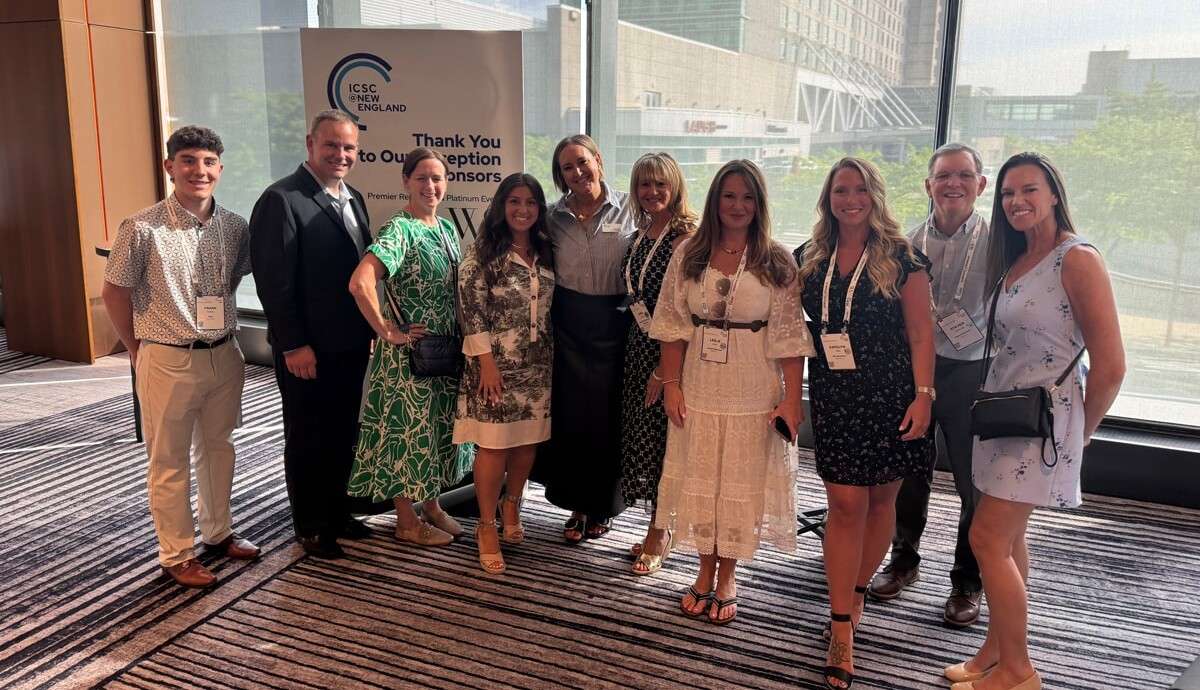
ICSC@NEW ENGLAND 2025 was more than a retail real estate conference—it was a high-impact gathering of visionaries, thought leaders, and dealmakers shaping the future of commerce in the Northeast.

ICSC@NEW ENGLAND 2025 was more than a retail real estate conference—it was a high-impact gathering of visionaries, thought leaders, and dealmakers shaping the future of commerce in the Northeast.
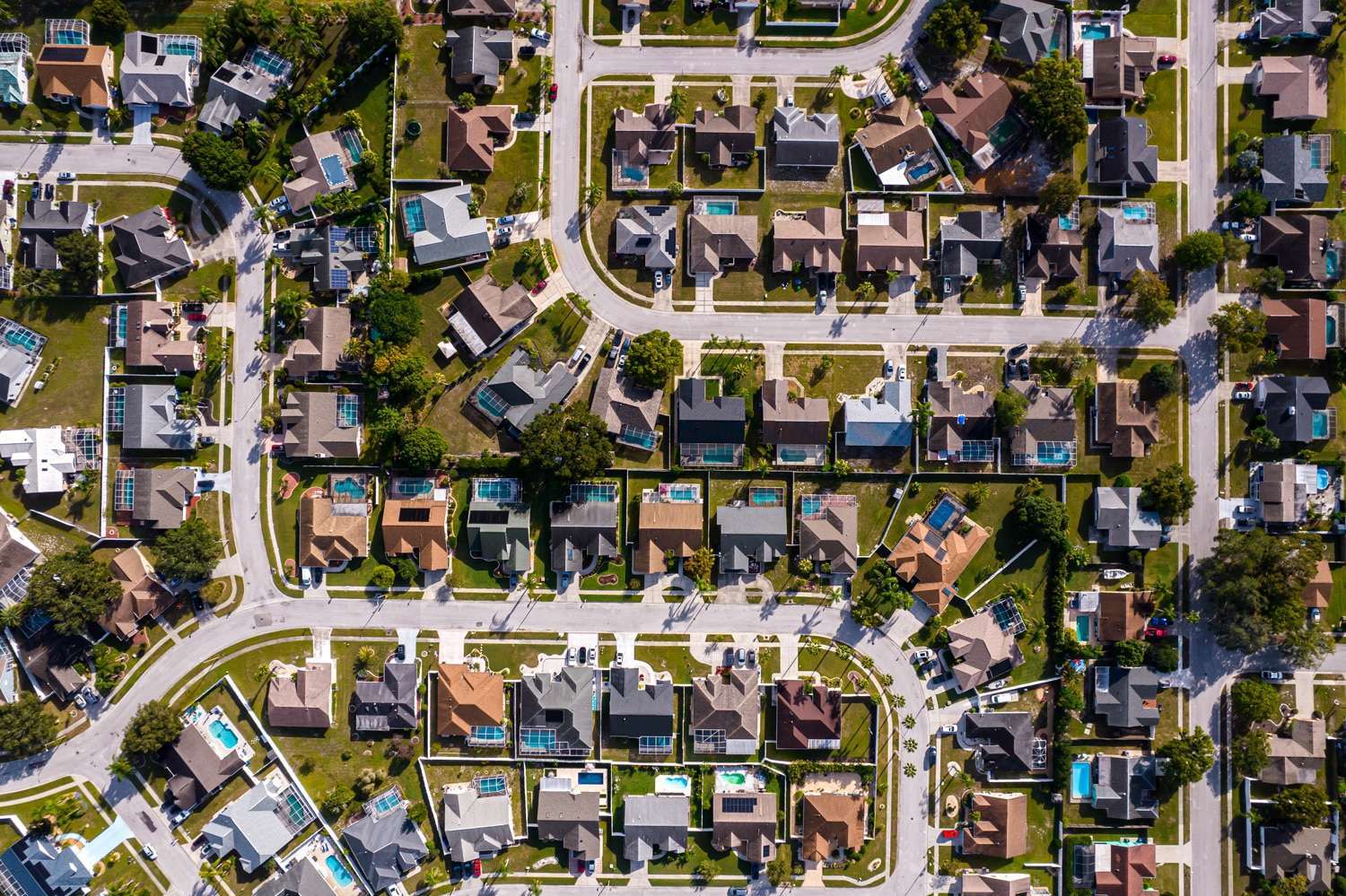

By Amanda Mitchell, Manager of Permitting Services

Amanda Mitchell, Manager of Permitting Services
Recently, the Orange County Board of County Commissioners took a decisive step toward reshaping the region’s future by adopting Vision 2050 and the new Orange Code. These landmark initiatives are designed to modernize the county’s approach to growth, development and community planning.
The Orange Code, set to take effect in mid-July, will replace the decades-old Land Development Code (LDC), introducing a more flexible and forward-thinking regulatory framework. Simultaneously, the County’s Comprehensive Plan has been updated and rebranded as Vision 2050, incorporating over 30 years of planning insights and addressing more than 60 years of evolving land use needs.
Before Vision 2050 can be fully implemented, it must pass a compliance review by the Florida Department of Economic Opportunity (DEO) to ensure alignment with state planning laws. Once approved, both Vision 2050 and the Orange Code will serve as a transformative foundation for how Orange County manages growth and preserves its unique character. These updates are expected to bring greater zoning flexibility, streamlined permitting and approval processes, and clearer design standards— all of which aim to support more predictable, efficient and sustainable development.
In this post, we’ll explore the most impactful changes and challenges and what they mean for businesses in the commercial development sector.
New Development and Redevelopment of PDs
The adoption of the Orange Code brings a major shift for developers. Whether pursuing new development or revisiting existing Planned Developments (PDs), the Orange Code presents new design challenges to align with the county’s new vision.
What’s the vision? Form-based, intentional and predictable growth with a desire to create place, experience and community. A great example of this type of planning and design in action is Baldwin Park, one of the most well-known master-planned communities in Central Florida. Developed with a strong emphasis on walkability, public realm design and architectural cohesion, Baldwin Park embodies many of the principles that the Orange Code now seeks to replicate countywide.
The Orange Code has a significant impact on how developers approach entitlements, design and approvals. Existing PDs are no longer the assumed standard, and new proposals must meet stricter design requirements under Transect Zones.
For New Development: Embrace the Orange Code
Developments under six acres that do not involve subdivision can proceed directly to permitting, bypassing rezoning or additional public hearings and significantly reducing permitting timelines.
For Redevelopment: Plan for Transition
Opportunities and Advantages
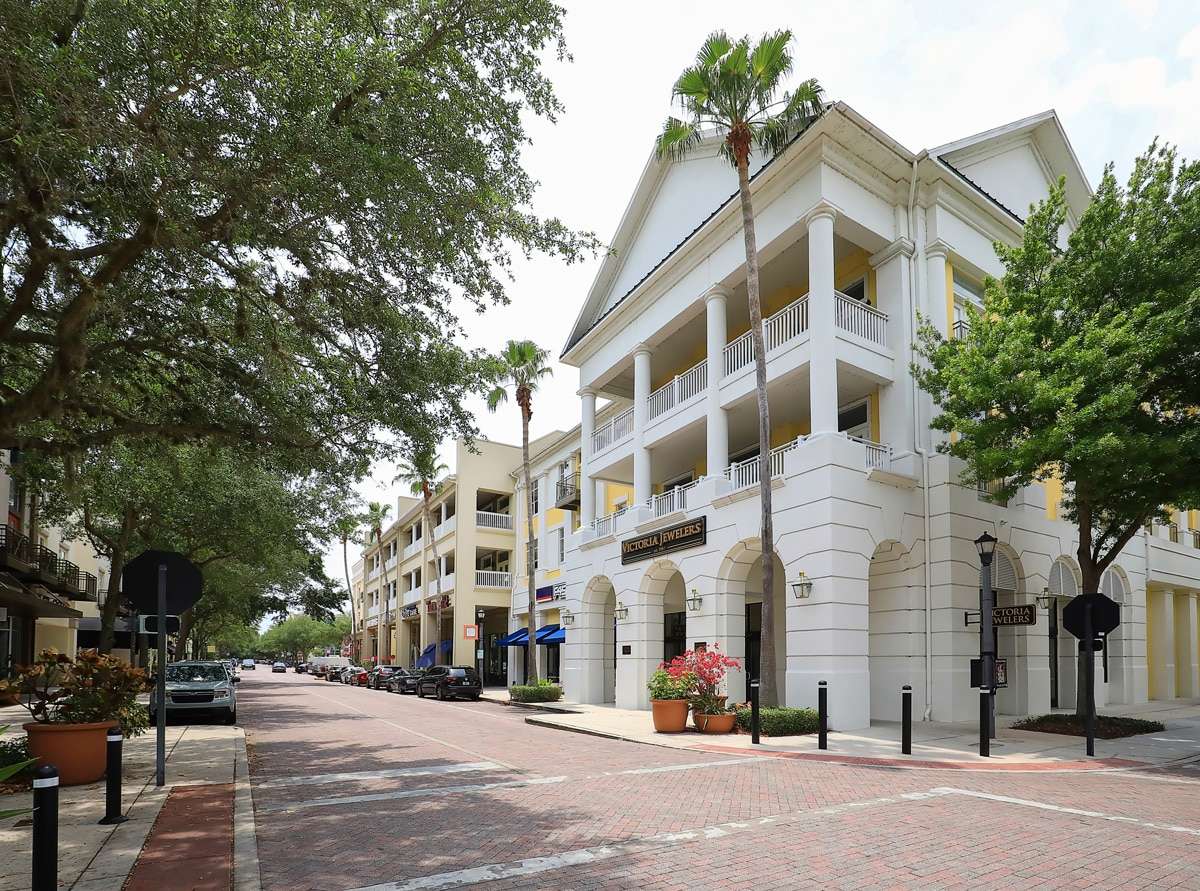
New Architectural Design Standards
The Orange Code makes architectural design non-negotiable and transparent. It defines what good design looks like across various scales and settings, providing developers with a more straightforward path to approval while also demanding higher-quality outcomes, particularly in retail, mixed-use and urban infill settings. The Orange Code supports developers in meeting these elevated requirements by offering a broad menu of additional design elements—an area previously deficient in the former LDC.
Retail buildings must now meet mandated transparency ratios for storefronts along primary frontages— typically requiring a minimum percentage of clear glazing at the pedestrian level.
From a developer’s perspective, mandated transparency ratios for storefronts represent both a design challenge and a potential market opportunity. Meeting the required percentage of clear glazing along pedestrian-facing facades may necessitate rethinking conventional layout strategies, particularly for prototypical retail and QSR buildings that favor branding over visibility. When thoughtfully applied, transparency and articulation requirements can elevate curb appeal, support leasing goals and better integrate retail into walkable, mixed-use environments.
Drive-Thru Design & Pedestrian Engagement
Retail development—particularly Quick-Service Restaurants (QSRs) and other auto-centric uses—will face new design expectations under the Orange Code. Traditional drive-thru layouts that prioritize vehicle stacking and circulation over pedestrian engagement must now be reimagined.
The code emphasizes urban form, building orientation and pedestrian access, which limits where drive-thrus can be placed and how they interact with the street. For example, drive-thru lanes can’t separate the building from the roadway. This can be challenging for QSRs that depend on fast, high- volume vehicle flow. Smaller sites may find it harder to fit these new standards, which could affect efficiency and overall site feasibility.
Elevated Landscape Requirements & Roadway Design
The Orange Code elevates the role of landscaping and street-level design in creating cohesive, high-quality developments. Landscaping is no longer just about code compliance—it’s an integrated component of the built environment. Projects must incorporate:
The code also emphasizes roadway engagement to ensure buildings contribute meaningfully to the public realm:
From a development perspective, these requirements mean greater upfront site planning coordination and design investment. Landscape architects and civil engineers must be involved earlier in the process to ensure compliance with frontage design, shading ratios and canopy coverage. While these standards may increase design and construction costs, they also create opportunities to enhance project appeal, increase tenant satisfaction, and contribute to long-term property value. In short, the Orange Code’s elevated landscape and roadway engagement standards reflect a commitment to quality placemaking, and developers who integrate them effectively will position their projects for greater success.
The Orange Code aims to simplify and clarify the development approval process by introducing a more streamlined approach to approvals through clear, form-based standards. This leads to a more predictable permitting timeline, especially for projects that meet the code’s prescriptive design and layout requirements. For example, new developments under six acres that do not require subdivision may proceed directly to permitting without rezoning, public hearings, or TRG (Technical Review Group) review, significantly shortening the approval window. This helps alleviate many of the inherent headaches that developers experience during the permitting process, such as unexpected delays, unclear requirements and shifting expectations.
However, the higher level of design and documentation required for compliance means that early coordination with design professionals and county reviewers is more important than ever. Developers and retailers alike should expect a more front-loaded permitting process, where detailed site planning, architectural elements and public realm features must be resolved earlier in project development. When well-prepared, this approach can reduce uncertainty and accelerate time to construction.
How Cuhaci Peterson is Supporting Clients Through the Transition to Orange Code
At Cuhaci Peterson, we understand that navigating a new regulatory landscape can be complex—but it also presents exciting opportunities for innovation and leadership in design. Our Permitting services team is actively working with clients to interpret the Orange Code, assess project impacts, and develop strategies that align with the county’s new vision.
We offer:
Success under the Orange Code requires more than entitlements—it demands thoughtful design. Engaging a professional architectural team that conducts thorough due diligence and understands the technical and design standards of the Orange Code is essential. Using a team that includes permitting expertise further ensures a smooth path from concept to construction. Cuhaci Peterson is an industry leader that combines architectural design, code compliance strategy and permitting services under one roof. Our integrated approach shortens timelines, minimizes risk and helps navigate Orange County’s evolving regulatory landscape. With decades of experience and a strong reputation for excellence, we are a trusted partner in turning development visions into fully realized, successful outcomes that bring your design visions to life.
NOTE: Some of the information contained in this blog was obtained via the official Vision 2050 and Orange Code website. We encourage you to visit that site for future updates to rules and regulations.
Kraig Koelsch
Manager, Marketing and Communications
407-661-9100
kraig.koelsch@c-p.com
Cuhaci Peterson Maitland (HQ)
Subscribe to our newsletter and get the latest news and updates
About Cuhaci Peterson®
Cuhaci Peterson is a nationally recognized architecture, engineering and planning firm specializing in end-to-end commercial design solutions. Headquartered in Central Florida, the firm has representatives throughout the United States and is licensed in all 50 states. Cuhaci Peterson’s mission of transforming ideas into a value is enhanced by a staff of experts who collaborate with clients to translate visions into designs that elevate brands.
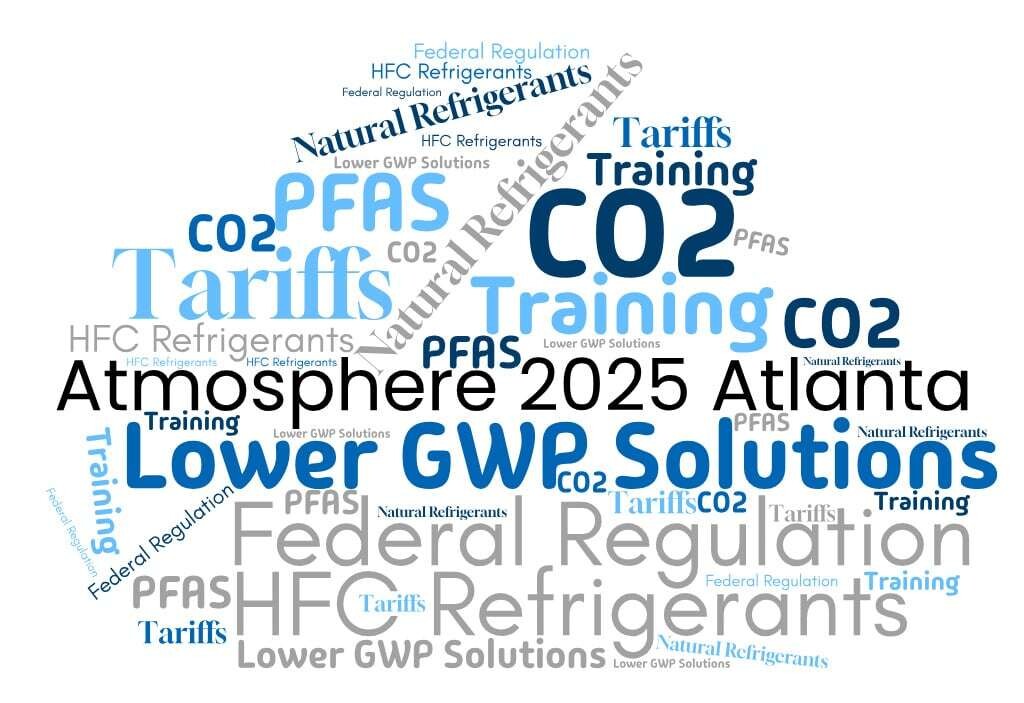
Regulations on refrigerants
Federal and state regulations are driving the U.S. industry away from hydrofluorocarbons (HFCs) and toward refrigerants with lower global warming potential (GWP). On the federal level, this transition gained significant momentum with the passage of the AIM Act in 2020. Recently, however, the U.S. EPA announced it is reconsidering the Technology Transitions Rule—one of the AIM Act’s three main pillars—potentially delaying upcoming compliance dates.
Despite this, industry sentiment suggests that even if federal implementation is postponed, the broader move toward low-GWP refrigerants will remain on course. Bipartisan backing for the AIM Act and sustainability pledges from major retailers indicate that any regulatory slowdown is likely to be short-lived. Meanwhile, several states, including California, New York and Washington, are independently advancing their own regulatory timelines, reinforcing the industry’s overall shift toward more sustainable practices.
Growth of Natural Refrigerant Adoption
The use of natural refrigerants is growing in U.S. commercial and industrial applications. Retailers are increasingly adopting them across their stores as a sustainable, future-proof solution against current and future regulations in their refrigeration systems. Additionally, the shift to natural refrigerants is a key piece for many retailers to meet their internal sustainability goals. A few key retailers making the shift to natural refrigerants include Aldi and Ahold Delhaize.
Why Adopt CO2?Although not the only refrigerant solution, CO2 is poised to be a leading refrigerant for many grocers due to its ultra-low global warming potential (GWP) and A1 safety classification, making it a natural refrigerant that aligns with regulation and sustainability trends. Extensively used in Europe’s commercial refrigeration sector for decades, CO2 is a proven and versatile refrigerant, appearing in systems such as pumped secondary, cascade or transcritical booster designs.
Equipment manufacturers are actively implementing technology to enhance CO2 system efficiency across various climates. However, each technology must be carefully assessed for its specific application by end-users, given the increased system complexity and costs.
PFAS
Lower-GWP synthetic refrigerants and blends are increasingly being explored as viable alternatives to natural refrigerants. Retailers considering these should remain educated as potential regulation of PFAS, or better known as “forever chemicals”, is becoming an increasingly relevant topic in discussions about many of these lower GWP synthetic refrigerants.
A particular focus is on TFA (trifluoroacetic acid), a short-chain PFAS that can form as a breakdown product of certain refrigerants. Due to its stability and water solubility, TFA has been found in rainwater, soil, and even drinking water sources. That said, any regulatory measures remain in the early, exploratory stages.
TrainingWorkforce training emerged as a central theme across the conference, with alignment from all stakeholders—from end-users to engineers, manufacturers, and contractors. The shared concern is twofold: a rapidly aging technician workforce with limited new talent entering the field, and the introduction of unfamiliar refrigeration technologies.
This combination is expected to create a scarcity of expertise, positioning skilled labor as an essential asset. As a result, there is a strong consensus that now, more than ever, targeted investment in training, particularly in field maintenance and installations, is essential for maintaining compliance and operational resilience.
Please get in touch with Kyle or Steven directly to learn more or discuss how Cuhaci Peterson can assist you with all your refrigeration needs.
Kraig Koelsch
Manager, Marketing and Communications
407-661-9100
kraig.koelsch@c-p.com
Cuhaci Peterson Maitland (HQ)
Subscribe to our newsletter and get the latest news and updates
About Cuhaci Peterson®
Cuhaci Peterson is a nationally recognized architecture, engineering and planning firm specializing in end-to-end commercial design solutions. Headquartered in Central Florida, the firm has representatives throughout the United States and is licensed in all 50 states. Cuhaci Peterson’s mission of transforming ideas into a value is enhanced by a staff of experts who collaborate with clients to translate visions into designs that elevate brands.
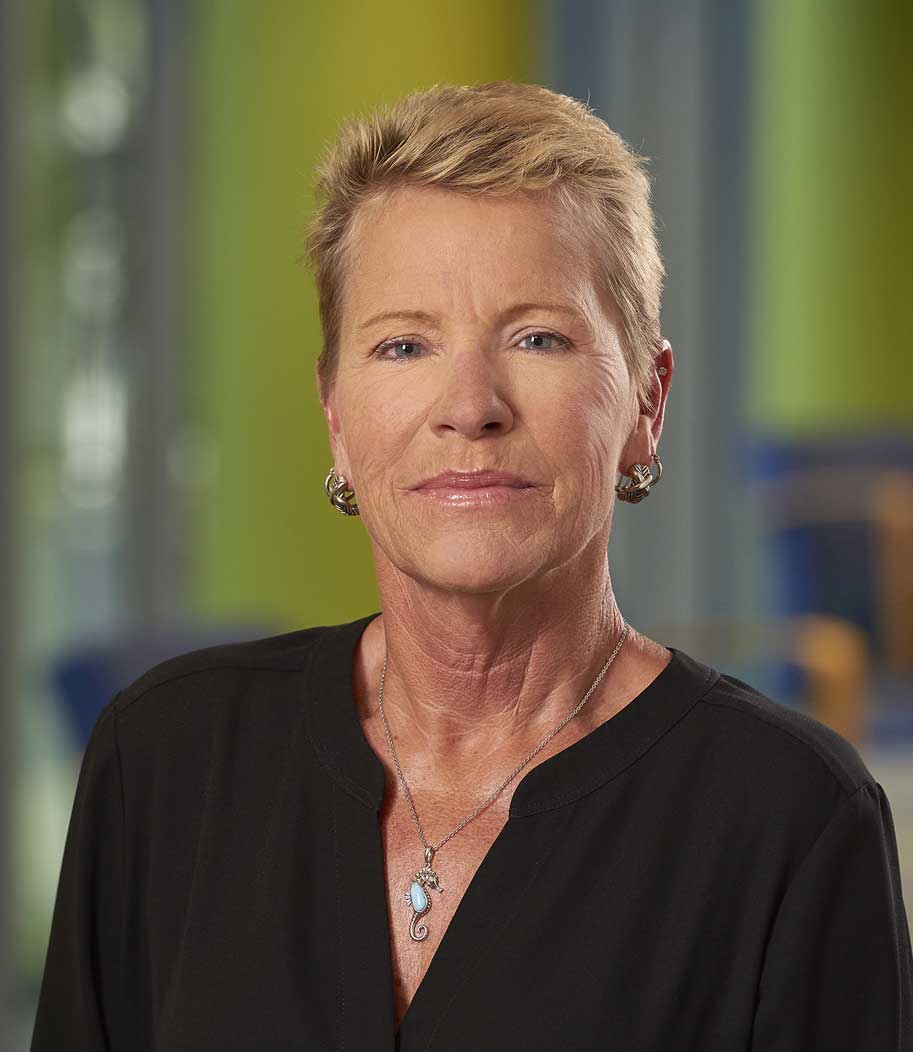

Kraig Koelsch
Manager, Marketing and Communications
407-661-9100
kraig.koelsch@c-p.com
Cuhaci Peterson Maitland (HQ)
Subscribe to our newsletter and get the latest news and updates
About Cuhaci Peterson®
Cuhaci Peterson is a nationally recognized architecture, engineering and planning firm specializing in end-to-end commercial design solutions. Headquartered in Central Florida, the firm has representatives throughout the United States and is licensed in all 50 states. Cuhaci Peterson’s mission of transforming ideas into a value is enhanced by a staff of experts who collaborate with clients to translate visions into designs that elevate brands.
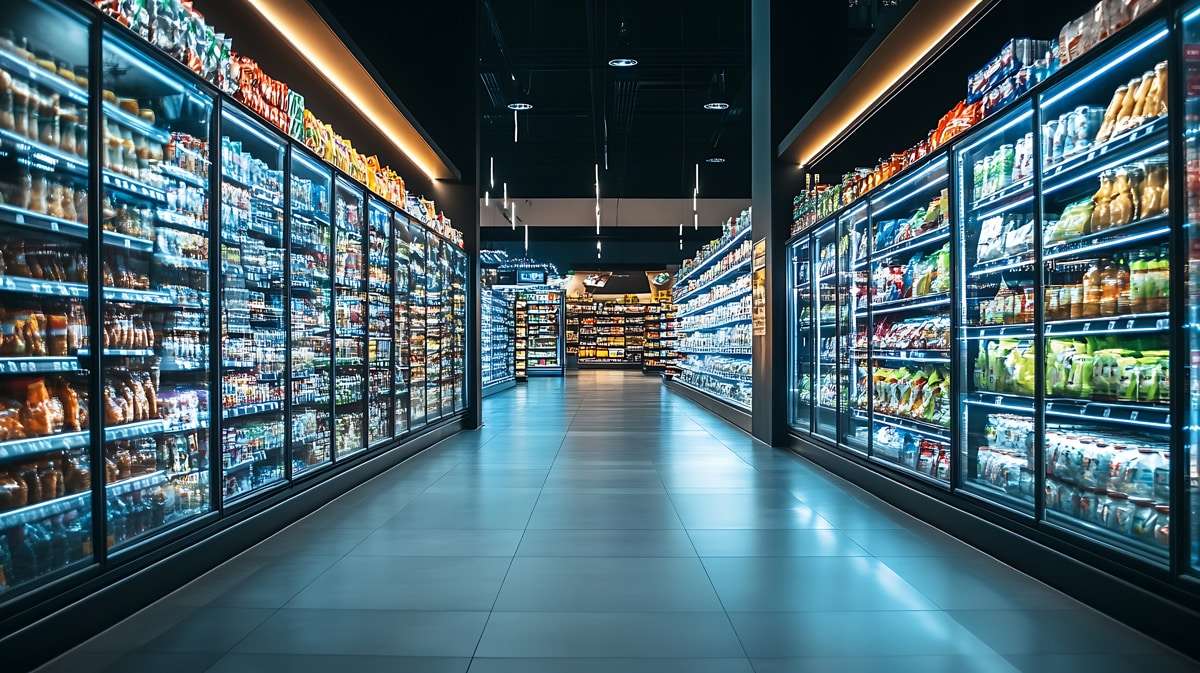
The question of whether refrigerant regulations will be rolled back is on the minds of many end-users. On March 12, 2025, the U.S. Environmental Protection Agency (EPA) announced its plan to reconsider the Technology Transitions rule.
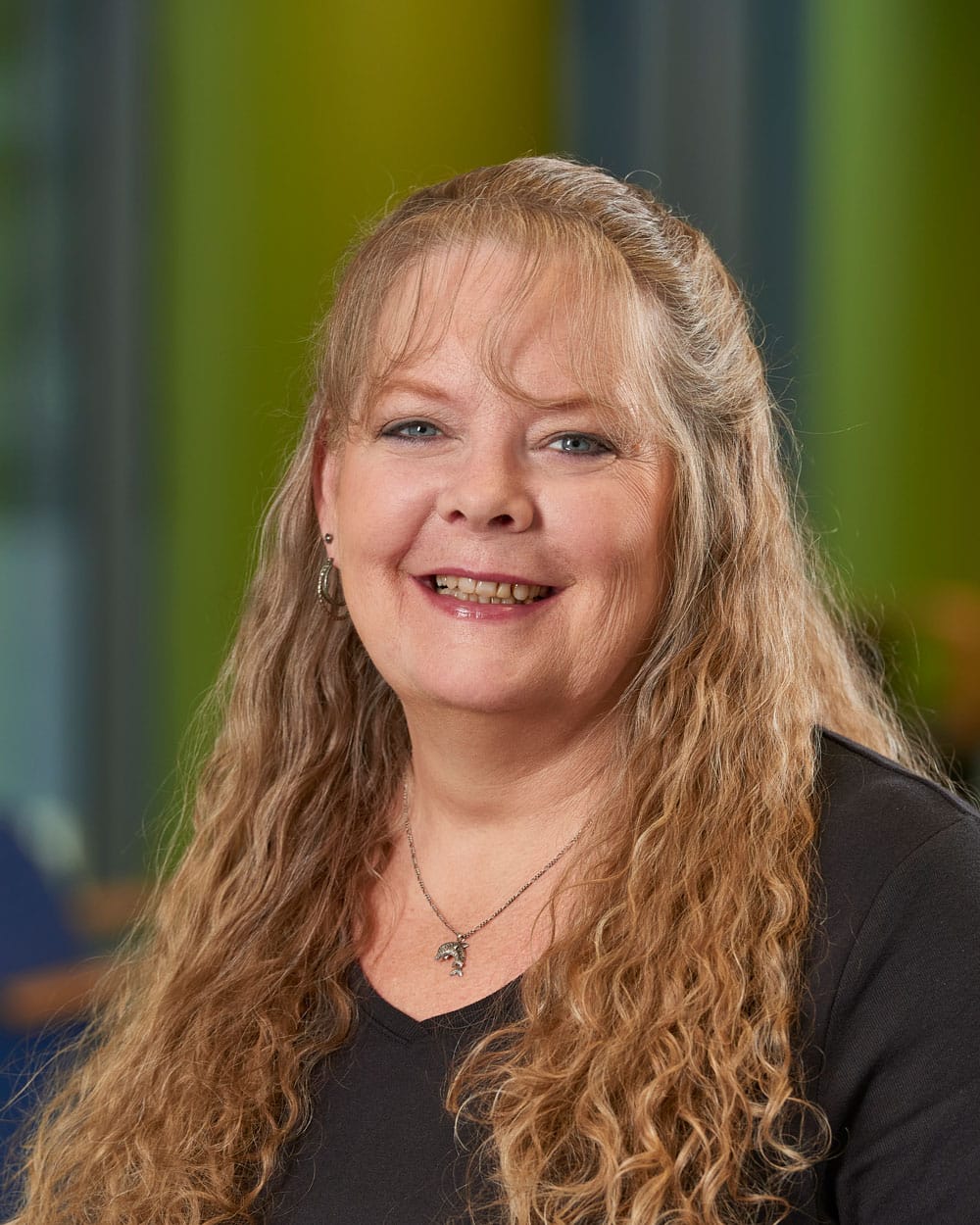
At first glance, Kim Harold might just seem like a project manager, deeply immersed in the intricacies of the architecture and engineering industry. But dig a little deeper, and you will uncover her world full of passions that go far beyond the drafting table.

Kraig Koelsch
Manager, Marketing and Communications
407-661-9100
kraig.koelsch@c-p.com
Cuhaci Peterson Maitland (HQ)
Subscribe to our newsletter and get the latest news and updates
About Cuhaci Peterson®
Cuhaci Peterson is a nationally recognized architecture, engineering and planning firm specializing in end-to-end commercial design solutions. Headquartered in Central Florida, the firm has representatives throughout the United States and is licensed in all 50 states. Cuhaci Peterson’s mission of transforming ideas into a value is enhanced by a staff of experts who collaborate with clients to translate visions into designs that elevate brands.

Kraig Koelsch
Manager, Marketing and Communications
407-661-9100
kraig.koelsch@c-p.com
Cuhaci Peterson Maitland (HQ)
Subscribe to our newsletter and get the latest news and updates
About Cuhaci Peterson®
Cuhaci Peterson is a nationally recognized architecture, engineering and planning firm specializing in end-to-end commercial design solutions. Headquartered in Central Florida, the firm has representatives throughout the United States and is licensed in all 50 states. Cuhaci Peterson’s mission of transforming ideas into a value is enhanced by a staff of experts who collaborate with clients to translate visions into designs that elevate brands.
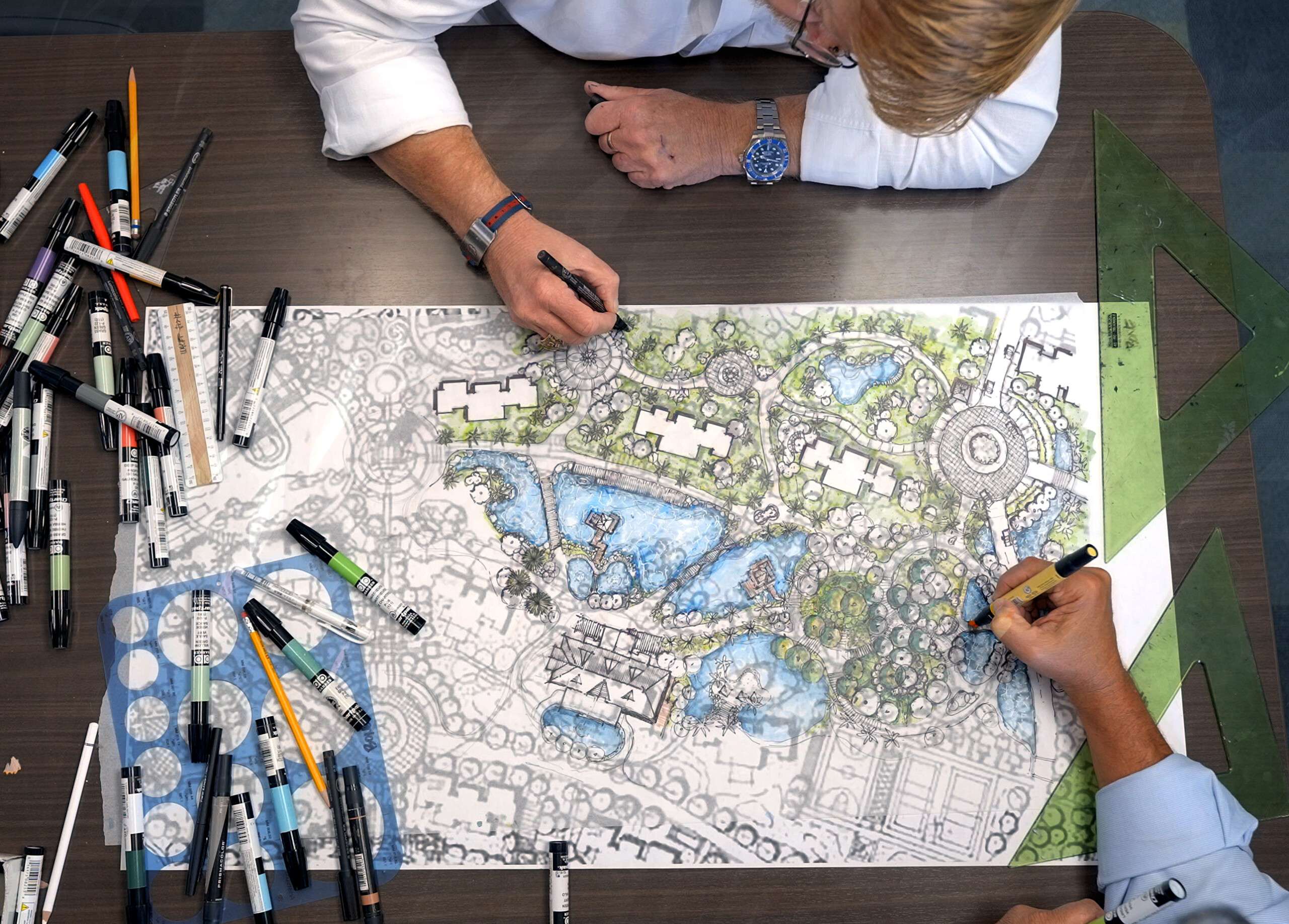
In the vibrant landscape of Florida, where sun-kissed beaches meet lush greenery, a groundbreaking new future of resort design concept is on the horizon, crafted by the talented team of Walter Bone and Juan Gimeno from Cuhaci Peterson. This innovative approach promises to redefine luxury living, seamlessly blending the natural beauty of the surroundings with world-class amenities. Central to this design is a meticulous hand sketching process, where the interplay of textures, line hierarchy and shade and shadow played a crucial role in bringing their vision to life.

At the heart of this development is the creative exercise of hand sketching, which served as the foundation for the entire design process. The duo believe that sketching allows for a more organic exploration of ideas, facilitating a deeper connection to the environment. Through this tactile approach, they could visualize how various elements would interact within the landscape, cementing the future of resort design.
Their sketches brought forth an array of textures — from the soft undulations of grass to the rugged surfaces of stone pathways. By employing line hierarchy, they guided the viewer’s eye, establishing a flow that mimics the natural rhythms of the landscape. The use of shade and shadow added depth, creating a sense of dimension that made the final concept feel alive and inviting.
One of the hallmark features of this concept is its expansive network of nature trails, designed to encourage guests to immerse themselves in Florida’s unique ecosystems. These paths will wind through lush gardens, native plantings and tranquil wooded areas, showcasing the region’s rich biodiversity.
The trails will be designed for accessibility, featuring smooth, wide surfaces that accommodate strollers and wheelchairs, ensuring that every guest can partake in the exploration. Informational signage along the way will educate visitors about the local flora and fauna, fostering a deeper appreciation for the environment and promoting eco-consciousness.
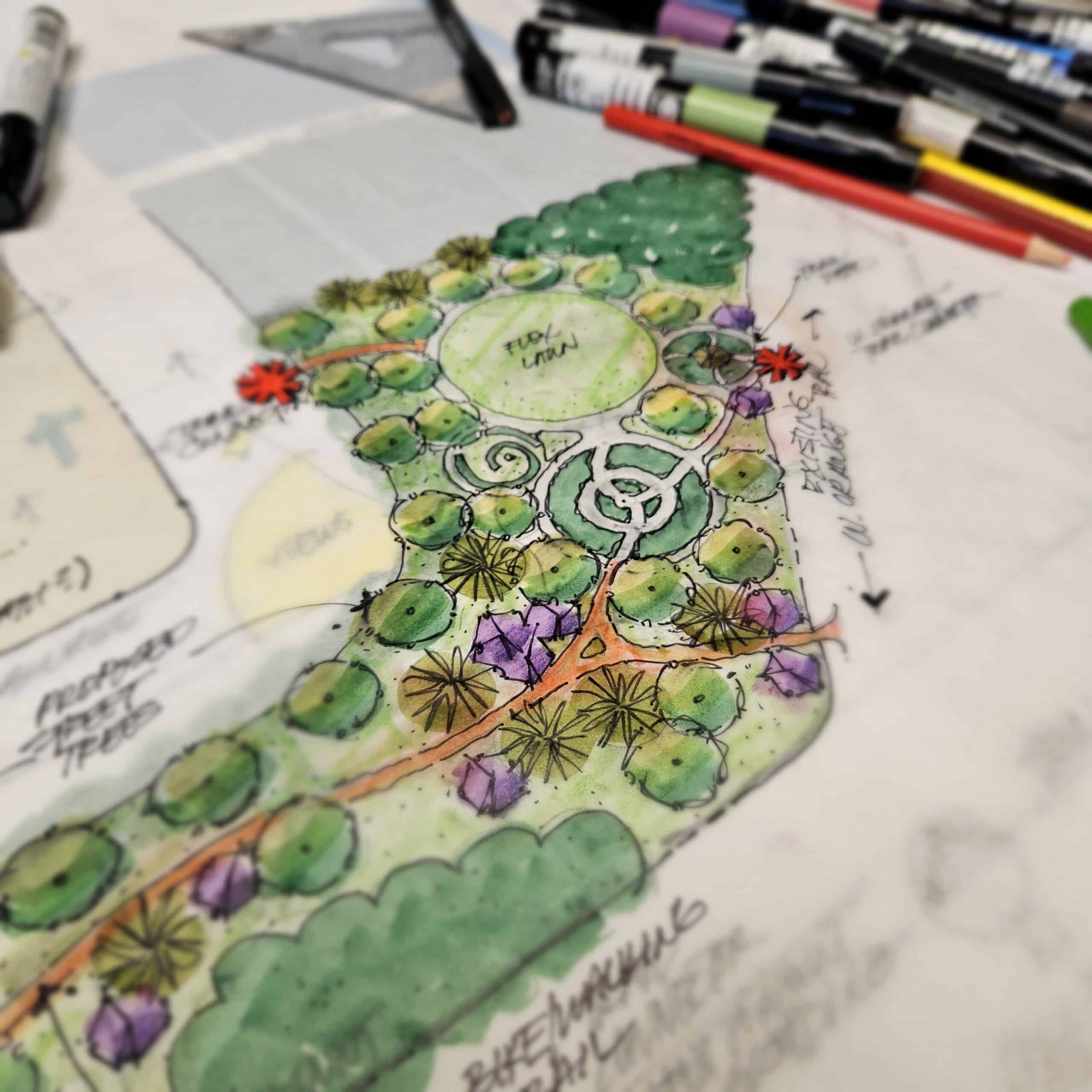
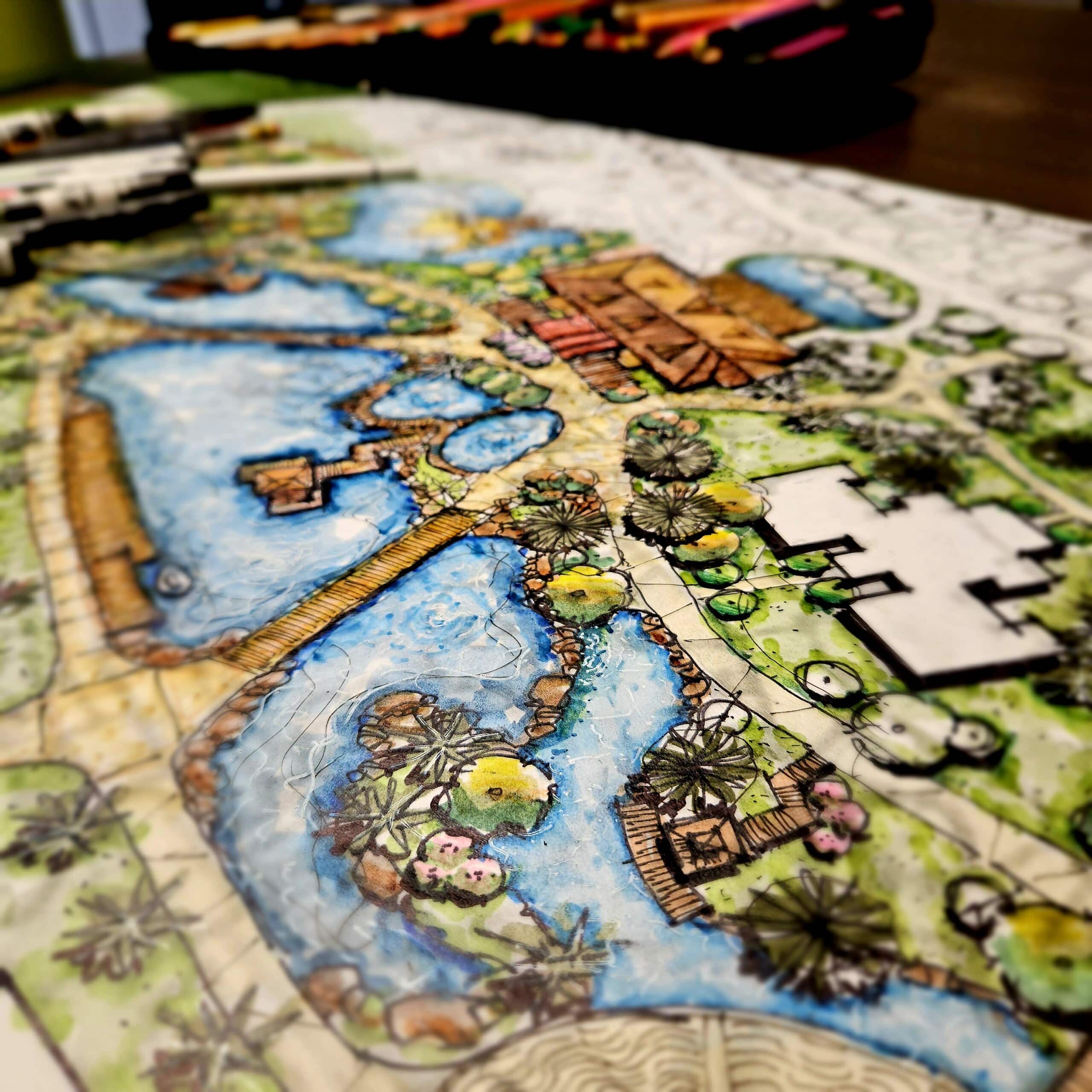
Water is a defining characteristic of any Florida resort, and this design takes it to new heights with innovative swimming complexes. Envisioned as serene retreats, these complexes will feature multiple pools, including an infinity pool that seemingly merges with the surrounding landscape, a family-friendly splash zone and a tranquil adult-only area.
The hand sketching process was instrumental in visualizing these water features, allowing Bone and Gimeno to experiment with textures and light reflections. The addition of natural elements — such as cascading waterfalls and lush tropical landscaping — creates an inviting oasis where guests can unwind and rejuvenate.
A diverse array of recreational amenities will ensure that there is something for everyone. For the active traveler, facilities will include tennis courts, fitness centers and outdoor yoga pavilions set against stunning backdrops.
Families will find plenty of activities to keep them entertained, including climbing walls, obstacle courses and interactive play zones, designed with safety and fun in mind. The sketches captured the playful spirit of these spaces, showcasing how they blend seamlessly with the surrounding landscape while providing safe, engaging environments for children and adults alike.
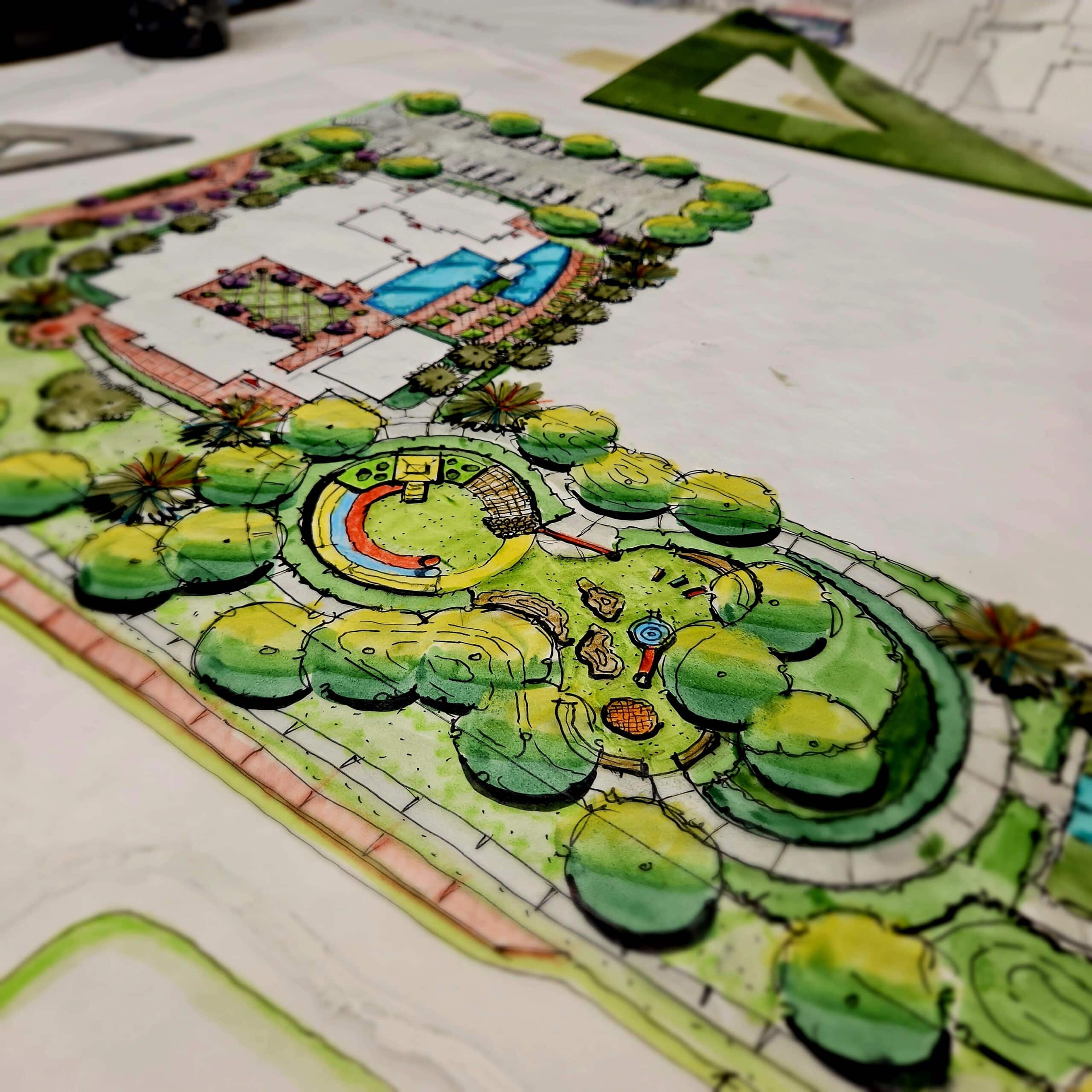
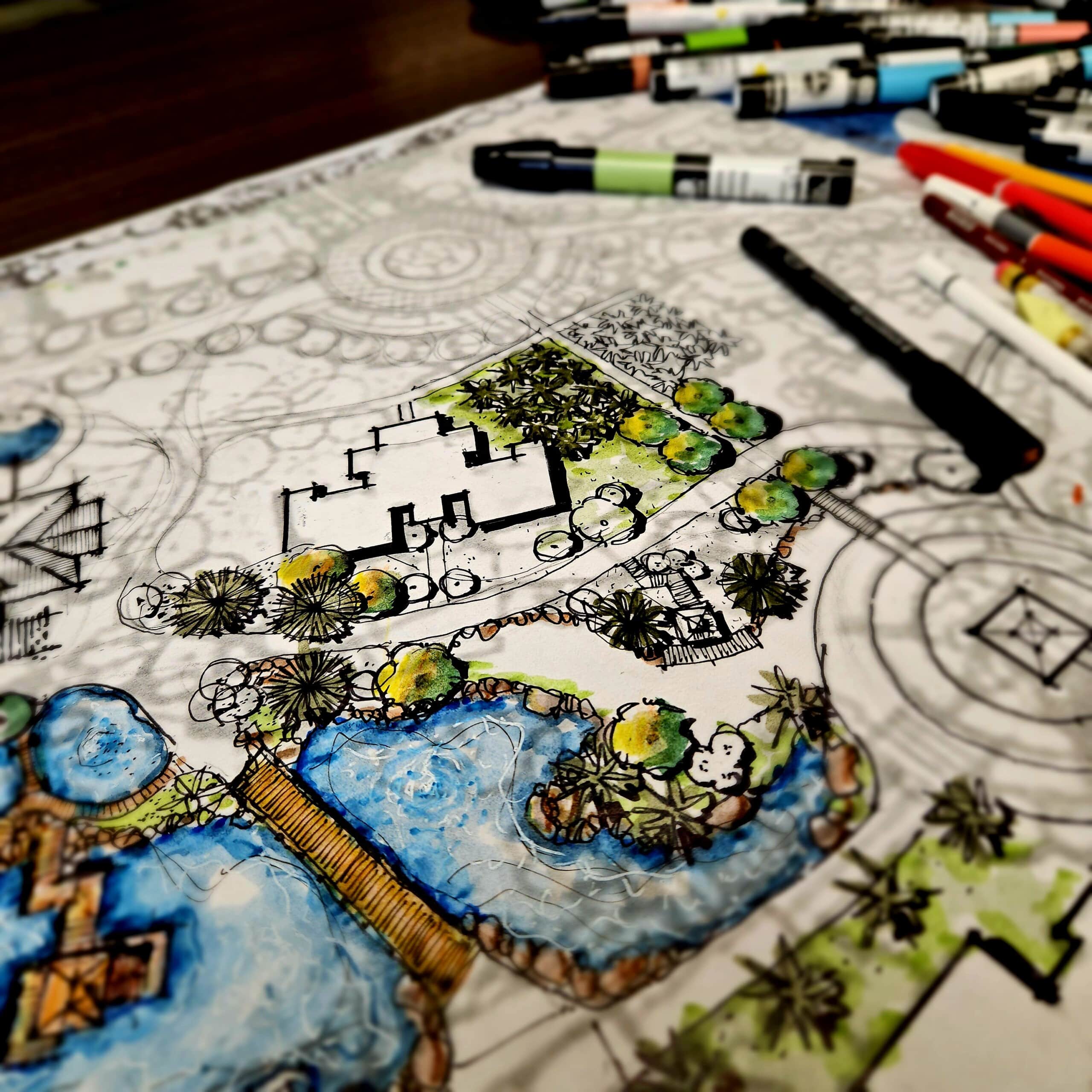
The design includes several picturesque ponds and lakes, integral to creating a tranquil atmosphere. These serene water bodies will provide opportunities for canoeing, paddleboarding and quiet fishing, allowing guests to connect with nature in a peaceful setting.
Bone and Gimeno envisioned these water features as more than just aesthetic additions; they are vital for the local ecosystem, attracting wildlife and enhancing the natural charm. The hand sketches reflected the interplay of light on the water’s surface, showcasing the calming effect of water while also highlighting areas for relaxation and reflection.
Attention to detail is a hallmark of this resort design, and the use of accent paving will create a cohesive and inviting atmosphere. Pathways will be carefully planned to guide guests through gardens and recreational areas, using eco-friendly materials that reflect the local environment.
Themed statuary will add an artistic flair, celebrating Florida’s rich culture and history. From whimsical sculptures depicting local wildlife to elegant representations of regional folklore, these art pieces will engage visitors and enhance the overall aesthetic. The sketches skillfully illustrated these artistic elements, demonstrating how they would enhance the guest experience while encouraging exploration.
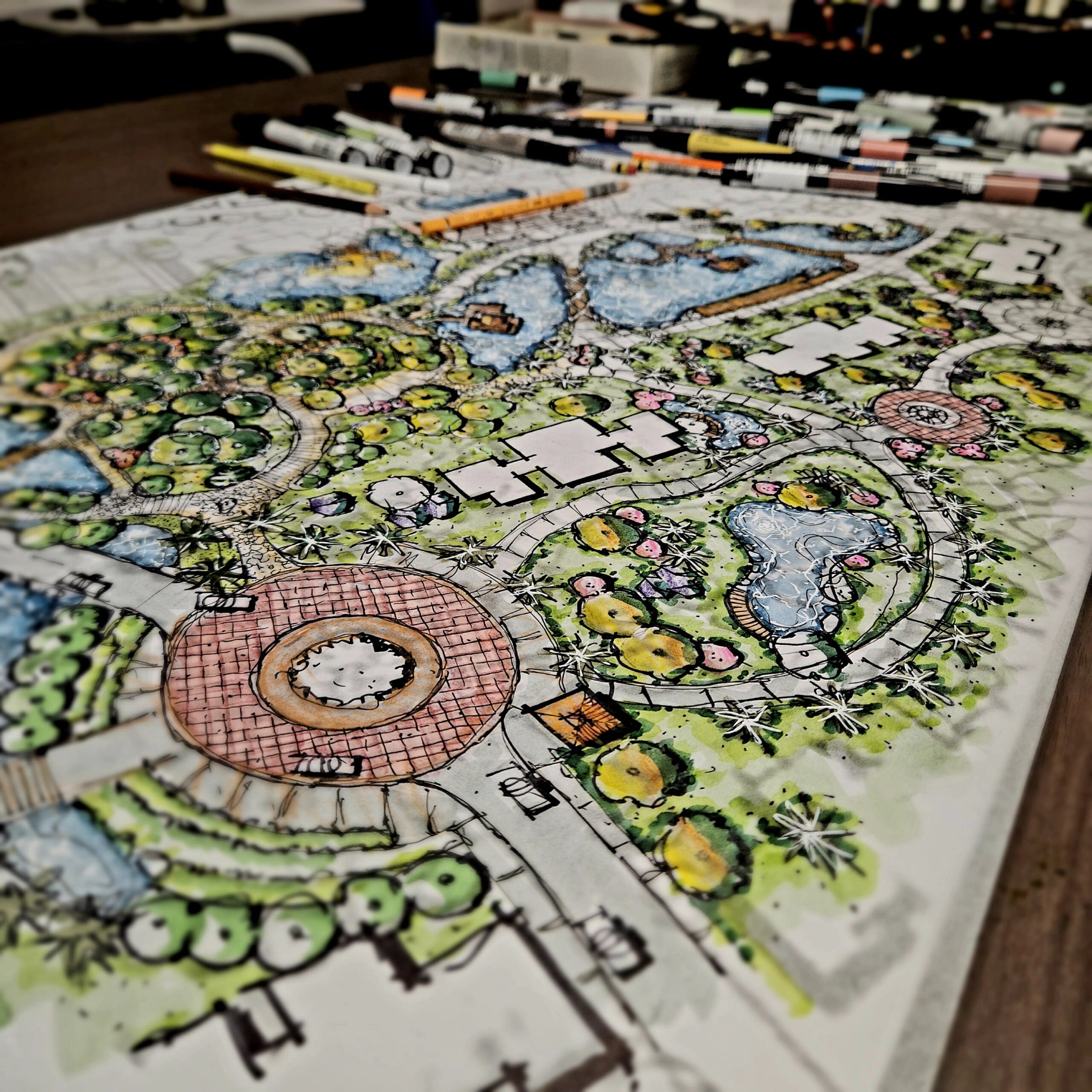
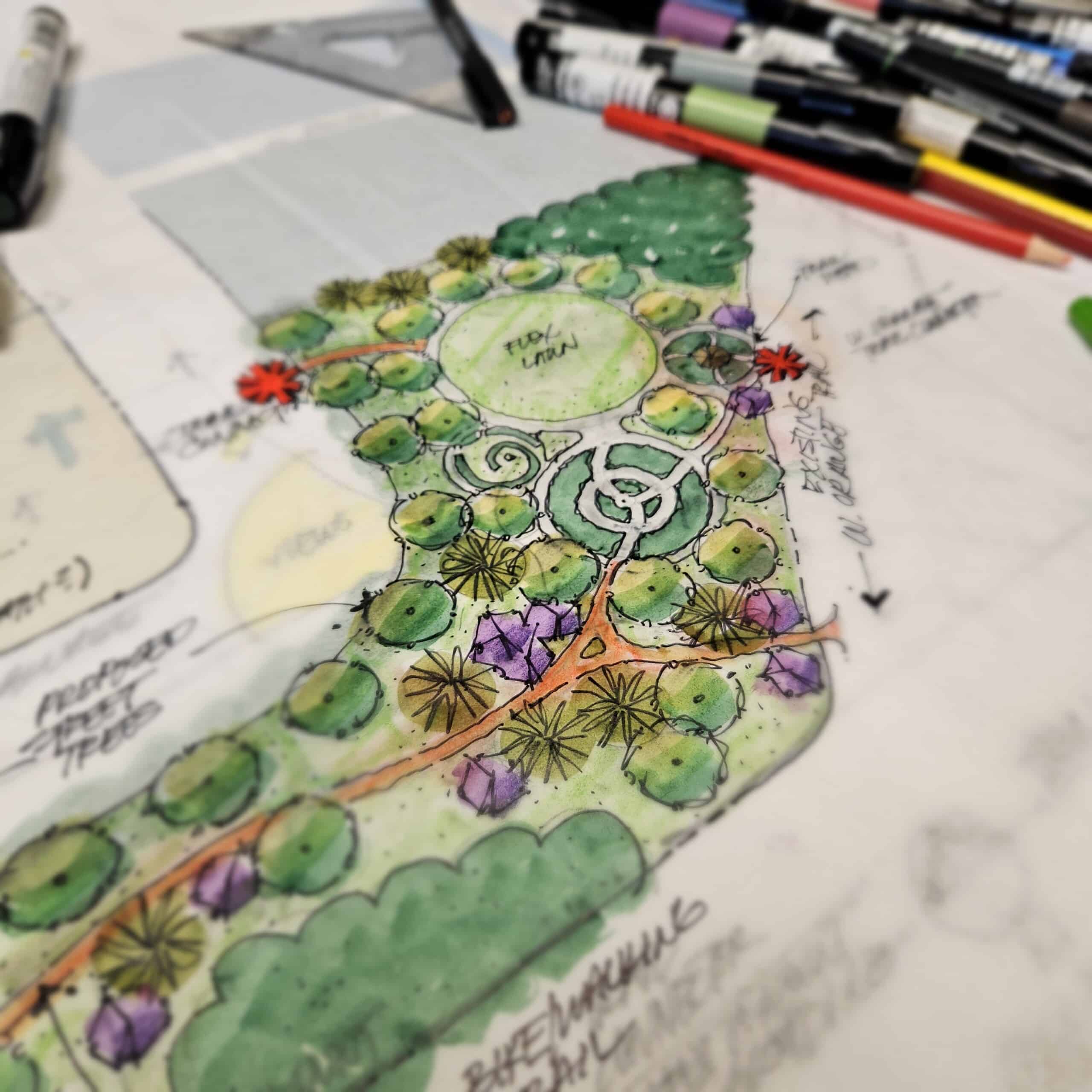
In today’s travel landscape, inclusivity is paramount, and this resort development concept prioritizes accessibility for all guests. The design features carefully planned layouts to ensure that everyone can navigate the resort’s design with ease. Accessible restrooms, pool lifts and wide pathways will allow individuals of all abilities to fully enjoy the amenities.
Moreover, the concept includes sensory-friendly spaces, designed to provide calm environments for guests who may feel overwhelmed in traditional settings. The commitment to inclusivity means that families, individuals and groups will all find a welcoming atmosphere.
As the Vice President of Design and Digital Practice, Juan Gimeno will be developing and overseeing design projects. With a Master of Architecture Degree, Juan has a strong educational background as well as over 20 years of professional design experience. With his multi-faceted approach to placemaking, Juan’s ability to achieve design revenues and meet business growth objectives in previous roles has resulted in 3 International Design Awards.
Juan has a keen eye for detail and combines his experience and creativity with exceptional organizational skills to deliver designs that exceed clients’ expectations. With work completed both internationally and in the United States, Juan has a whole-world approach to problem solving and strong ability to work on multiple projects simultaneously.
Walter is a seasoned Landscape Architect, overseeing all landscape-related projects for CP offices nationwide. He has contributed his expertise to public service, having served on the Design Review Commission for the City of Lakeland, TN, and is currently a Commissioner for the Historic Preservation Commission in New Smyrna Beach, FL.
From 2007 to 2019, Walter’s professional work spanned the globe, with projects across North America, the Middle East, Southeast Asia, and China. His portfolio includes a diverse range of project types such as roadway and transportation, municipal infrastructure, environmental planning and design, hotels and streetscapes, resorts, theme parks, mixed-use/commercial developments, and urban planning and design, with award-winning achievements on two continents.
Walter’s extensive experience also encompasses construction management, particularly in hotel resorts, theme and water parks, infrastructure, municipal projects, and high-end residential developments, making him a versatile leader in the field of landscape architecture and design.
About Cuhaci Peterson®
Cuhaci Peterson is a nationally recognized architecture, engineering and planning firm specializing in end-to-end commercial design solutions. Headquartered in Central Florida, the firm has representatives throughout the United States and is licensed in all 50 states. Cuhaci Peterson’s mission of transforming ideas into a value is enhanced by a staff of experts who collaborate with clients to translate visions into designs that elevate brands.
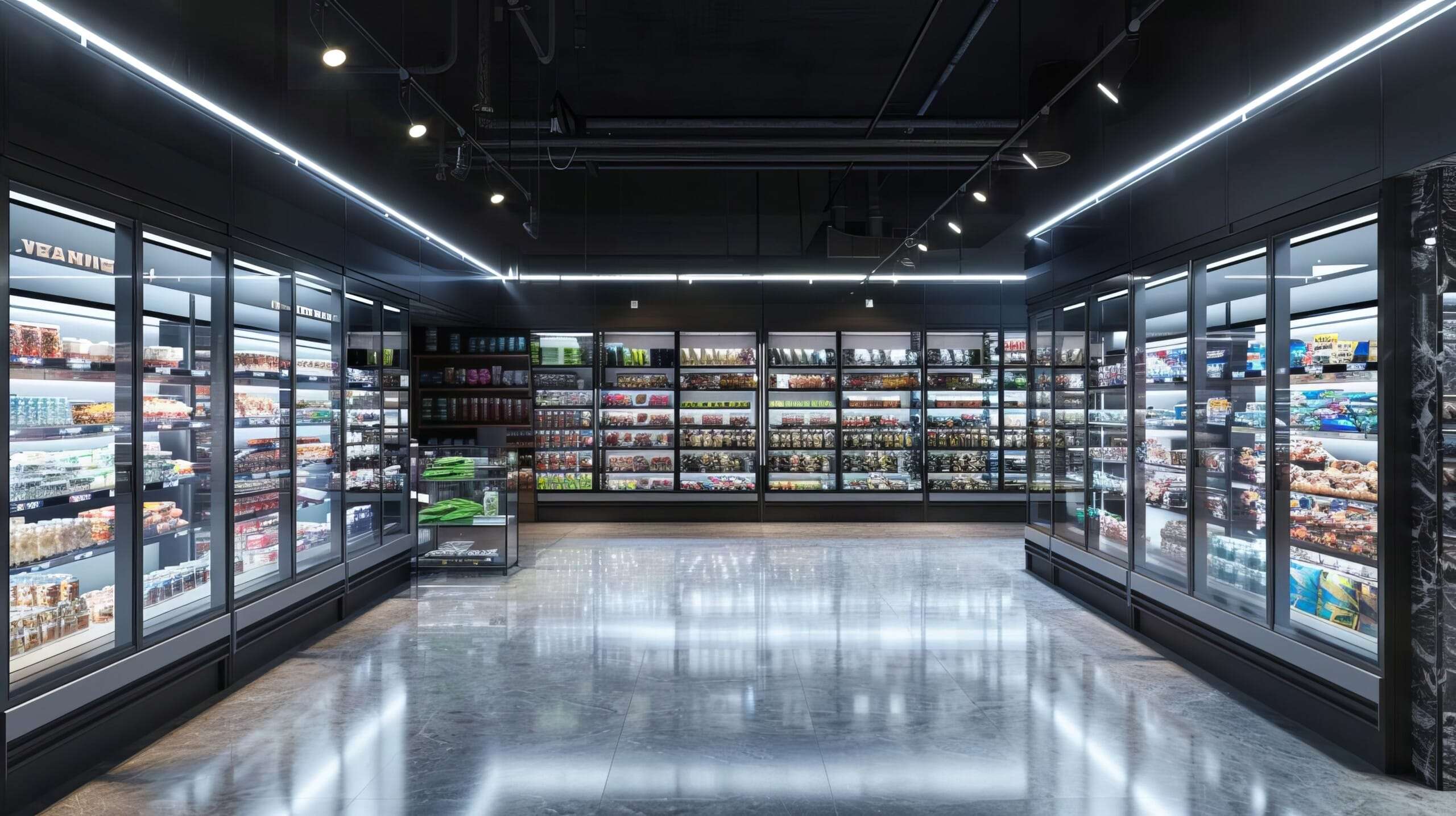
At the end of 2020, when many of us were spending time with our friends and family looking forward to the New Year, the U.S.federal government enacted and signed into law the American Innovation and Manufacturing (AIM) Act which was the next domino to fall in refrigeration regulations. The AIM Act looked to align with the Montreal Protocol (specifically the Kigali Agreement), which is a global agreement to address the depletion of the ozone layer and reduce the emissions of greenhouse gases. This set a schedule of the phase down of hydrofluorocarbon (HFC) refrigerants in the U.S. market while also empowering the U.S. Environmental Protection Agency to develop regulations to meet this schedule (See Important Dates for Retail Grocers Timeline). HFC refrigerants were specifically targeted due to their high global warming potential (GWP), which is a measure of how much energy the emissions of 1 ton of a gas will absorb over a given period of time, relative to the emissions of 1 ton of carbon dioxide as defined by the U.S. EPA. At the time of this writing, the EPA has begun managing HFC restrictions by mandating supply restrictions, establishing sector-based GWP limits, and creating/enforcing standards for servicing and repair of systems. For the commercial refrigeration sector, the New Equipment GWP limits table shows the scheduled GWP limits for new manufactured systems.
So what does this legislation mean to end-users today? Well, it certainly poses a huge hurdle in the U.S. market as common refrigerants that are found in grocery stores have a GWP that exceeds 1,000 (see Common Refrigerants Affected by this Phase Out). Do end-users have to have all existing systems replaced by these sector-based GWP limit dates? The short answer is no since these GWP limits only apply to new systems. However, the time to start planning a path forward is now as HFC supply restrictions and service/repair standards are also included in the latest rounds of regulations so the cost of maintaining these existing systems is likely to increase as time goes on. Additionally, the days of retrofitting existing systems by dropping in a new refrigerant and oil are approaching the end as there is no current refrigerant retrofit solution that will not require replacing major components such as compressors, condensers, or cases/coils. So what options do end-users have? Many end-users today are beginning to pivot to future-proof solutions on both remodels and new stores to meet regulatory requirements. Cuhaci Peterson Refrigeration has highlighted a few leading solutions below that are likely to be cornerstones of commercial refrigeration systems.
A system that only uses a non-flammable, low toxicity, natural refrigerant with a GWP of 1 would be one of the clear leaders in the clubhouse of future-proof solutions. Well, that is exactly what we have with a Transcritical CO2 Booster System. The system only uses R-744 (CO2) and can serve both low and medium temperature fixtures simultaneously making it a great option to reduce the number of systems running in a store. Additionally the thermodynamic properties of R-744 sets it up as a great refrigerant with high volumetric cooling capacity, meaning it can produce a lot of cooling with a low compressor displacement requirement. This results in smaller system components (compressors, valves, piping, etc.). So what is the catch? Transcritical CO2 booster systems face efficiency challenges in higher ambient conditions. Your standard refrigeration cycle works by absorbing or releasing energy by converting liquid into a gas and a gas into a liquid through heat transfer. However when refrigerants operate above specific temperatures and pressures, they can no longer be distinguished between a liquid and a gas and operate as a supercritical fluid. This specific temperature and pressure varies between refrigerants and is known as the critical point. As systems approach or exceed this critical point, they lose efficiency. This far and wide has been a non-factor as the critical points of many common refrigerants are well above outside air temperatures. R-744 is an exception. Its critical point is at a temperature of 87.8degF and 1056 PSIG. Therefore, systems that use R-744 and operate above or near its critical temperature require additional components to operate, such as a high-pressure expansion valve, flash gas bypass valve, and flash tank to drop its pressure below the critical point. These additional design solutions add complexity to the operation and installation, which often comes at a premium for end-users. There are ways to makeup for some of these efficiency losses through additional innovative components, such as ejectors, subcooling, and parallel compression, but similarly these additions come with complexity and cost which will continue to be a hurdle for wide acceptance of this system.
If we review the Transcritical CO2 Booster system, many of the counterpoints stem from utilizing R-744 in hotter climate zones. The easiest solution would be to install the system in a colder climate where the outside temperature stays well below the critical point of R-744 for most of the year. Unfortunately, that is not possible for a large section of the U.S. A great solution to ensure R-744 stays below its critical point is apply it in a cascade arrangement where the CO2 is only serving low temperature loads and is always condensed in a cascade heat exchange below it’s critical temperature by using a high side (non-CO2) refrigeration system to cool it. Another solution is to simply pump and circulate it as a saturated fluid and use a high side (non-CO2) refrigeration system to maintain the temperature of the CO2 and condense any evaporated CO2 back into a liquid. In principle, both systems work and accomplish the same result. They work by having two sides, a high side and low side, running simultaneously. The high side looks familiar to many refrigeration systems found in stores today where you have compressors discharging hot gas to a condenser that condenses the gas to a liquid state. However, instead of the liquid flowing out to a case or coil in the store, it flows to a heat exchanger that condenses the CO2 on the low side. On the low side, R-744 is a great option as we get all the benefits previously mentioned in the previous system while also removing the efficiency concerns in higher ambient temperatures since it is condensed with a heat exchanger that is independent from outside temperatures. On the high side, we are faced with challenges on what refrigerant to use. Pending regulations for new remote systems limit high sides to 300 GWP starting January 1, 2027. This means many of the current HFC refrigerants being used today will not be a viable option long term in the industry. However, a low side CO2 system poses a unique opportunity for remodel applications where an existing HFC rack serving a store’s cases/coils can be converted to be the high side of a newly installed low side system. This is likely to be an intermediate step for many end-users today as it will reduce the amount of HFC refrigerant at a store, utilize R-744 under conditions it is more efficient, and allow for tactical remodels or new builds until all current and future refrigerant options are adopted by regulatory jurisdictions and vetted out by the industry.
As mentioned previously, R-744 certainly has a bright future in commercial refrigeration due to its benefits; however, it should not be expected that R-744 will be the only solution in the industry. Many end-users in the industry have expressed understandable hesitation regarding the transition to R-744. This transition is likely to require higher installation and maintenance costs due to the complexity of the systems, volatility of the fluid, and higher operating pressure conditions. The higher operating pressure conditions also means when a leak does occur, it will leak rapidly and in recent time refrigerant-grade R-744 has faced sporadic supply challenges. Additionally, end-users that are conscious of net-zero goals need to consider how environmentally friendly R-744 systems truly are. Foremost, an argument can be made regarding the amount a grocer’s carbon footprint was lowered if the lower GWP system requires a significant increase in energy consumption where the energy is generated from a source with a high carbon footprint. Secondly, R-744 is typically produced in large industrial plants and must undergo additional refining to achieve a proper refrigerant-grade standard which is often done utilizing fossil fuels. However, when compared to the damage caused by a higher GWP refrigerant, the latter argument is likely insignificant. So the question many end-users approach is what other options are there outside of R-744? One option is to use a similar high side/low side setup as mentioned in the system above, but instead of pumping R-744 we can pump a food-grade water/glycol fluid in a glycol chiller system (a common mixture used today is 35% propylene glycol). However, this system runs into the same challenges as the above regarding many of the current HFC refrigerants being used today will not be a viable option long term in the industry. Additionally, it becomes very inefficient to pump glycol at freezing temperatures because the fluid becomes very difficult to pump with thick concentrations of glycol necessary for freeze protection. Therefore, self-contained fixtures using hydrocarbons such as R-290 (propane) may find their niche in commercial refrigeration. A condensing water loop can be used to cool the condenser on each self-contained fixture and reject the heat to the outdoor ambient through a fluid cooler. Due to the high flammability safety concern of R-290, charge limits are held very low resulting in mini compressor systems being needed at each case/coil. Although the GWP of R-290 is well below the regulatory limits, the safety concern and higher cost of equipment due to individual mini compressor systems often finds this being used on the low temperature applications within stores where a glycol chiller system is used on medium temperature applications.
All previously mentioned systems run into a variety of challenges that result in manufacturers and engineers having to add complexity to the designs when compared to the existing HFC systems that are running in many stores today. A standard direct expansion (DX) refrigeration system utilizing an A2L classified refrigerant has the potential to relieve some of these complexities for many end-users in the future. Utterly conventional in most ways, A2L classified refrigerant systems can be used in ways that are familiar in design to all refrigeration technicians making them easier to service while reaching regulatory GWP limits into the future. The major components of the system are the same four found in most grocery stores today: compressor rack, condenser, expansion valve and evaporator. These systems do not include the requirement for primary/secondary sides, booster system designs, nor electronic expansion valves with case controllers which can be seen as cost savings on equipment when compared to other leading solutions. Additionally, there is no significant efficiency penalty in higher ambient temperatures as seen with transcritical CO2 booster systems. Sounds like the clear answer for the system of the future, right? Not quite. The “catch” is A2L refrigerants are mildly flammable. When comparing an A2L classified refrigerant, R-454C, to an A3 classified refrigerant, R-290 (propane), it is seen that R-290 has a 4.5 times faster burning velocity and 7.5 times lower LFL (lower flammability limit in Lb/1000 ft^3) per ASHRAE 34. This means that an A2L refrigerant system charge can be significantly higher with proper safety mechanisms in place. These safety mechanisms include but are not limited to leak detection and means of shut offs throughout the system for leak mitigation, stricter circulation and ventilation requirements, additional pipe protection, and proper safety rated system components/equipment. Therefore, similar to the other previously mentioned systems, an A2L refrigerant cannot be used in a drop-in retrofit to an existing HFC system and will result in adding new compressors, condensers and cases/coils. However, a possible benefit of an A2L refrigerant system is some existing piping could be reused from a store’s system with correct verification and marking modifications. The challenges noted above for A2Ls are overall manageable especially when many end-users are confronted with the obstacles of the other leading design solutions. However, the biggest hurdle for widespread implementation of A2L refrigerants in U.S. commercial refrigeration is adoption by local and state jurisdictions. ASHRAE Standard 15 (safety code) was updated in 2022 to include requirements and larger changes for A2L refrigerants. However, ASHRAE does not equal building code at the state level and many jurisdictions have shown resistance to updating their legislation resulting in older standards being used. Older standards had little or no allowance for A2L refrigerants in direct systems so end-users are put in a vulnerable position where projects could be blocked by local jurisdictions and fire marshals. Possible regulations of PFAS, or better known as the “Forever Chemicals”, are also found in the conversation of A2L refrigerants in commercial refrigeration, but the extent of any regulation is still preliminary. The bright spot is trends show A2L adoption in commercial refrigeration will likely come as end-users, manufacturers and engineers all continue to lead the push but the question of when still remains. In the short term, A2L refrigerants in commercial refrigeration encounter several significant challenges for widespread adoption. However, in the long run, they could become an excellent solution, either as the primary side of a secondary system or in a standard DX refrigeration system, which we are all familiar with today.
Kyle Klahre is a licensed professional engineer and certified energy manager with expertise in refrigeration and energy management design and consulting. He has a strong track record of creating innovative, sustainable design solutions that drive cost savings while adhering to the evolving regulations of the refrigeration industry. In his current role as Director of Refrigeration at Cuhaci Peterson, Kyle focuses on assisting current and prospective clients in navigating the complex regulatory landscape of refrigeration, ensuring they find the optimal system for their needs.
About Cuhaci Peterson®
Cuhaci Peterson is a nationally recognized architecture, engineering and planning firm specializing in end-to-end commercial design solutions. Headquartered in Central Florida, the firm has representatives throughout the United States and is licensed in all 50 states. Cuhaci Peterson’s mission of transforming ideas into a value is enhanced by a staff of experts who collaborate with clients to translate visions into designs that elevate brands.
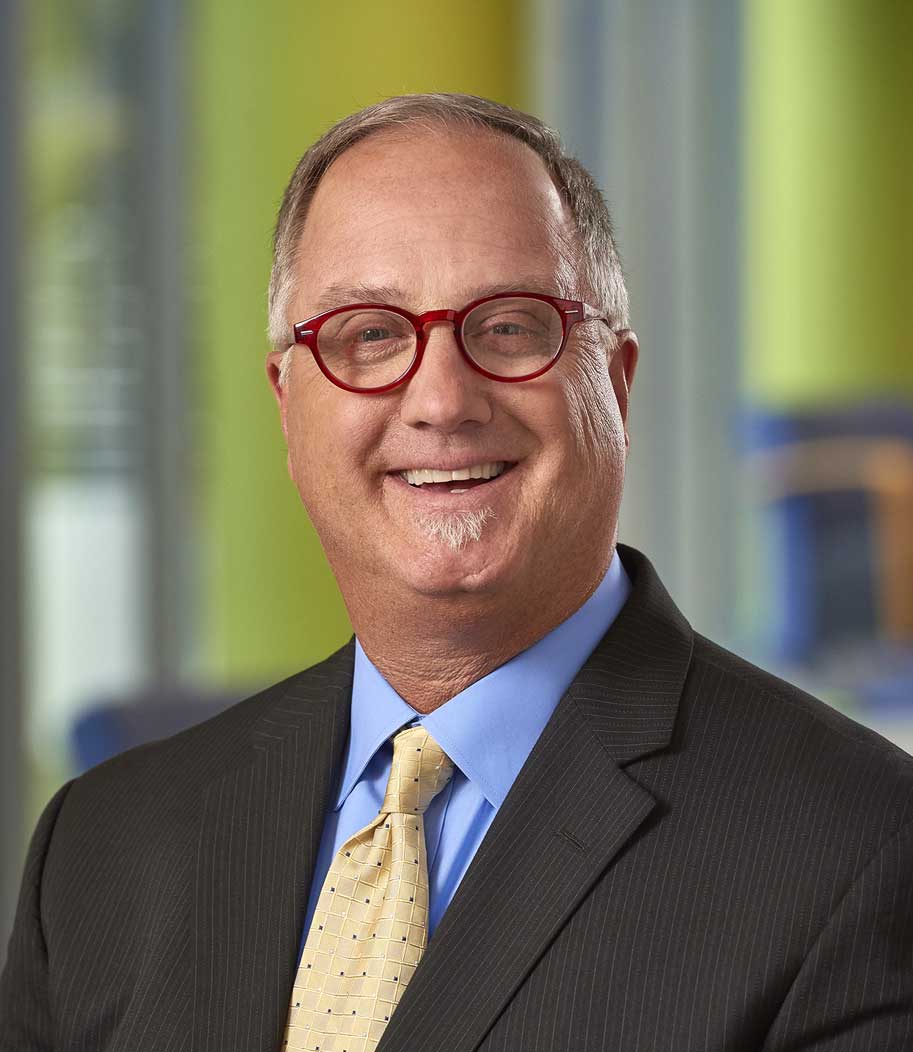
August 19, 2024
ICSC@FLORIDA is always a huge opportunity for not only Cuhaci Peterson, but for many of those connected to ICSC. Ahead of this year’s event, our Bill Tomala, Managing Director U.S. Client Experience, had a chance to sit down with the ICSC team for a five-part question and answer session.
What motivated you to get involved in Government Relations?
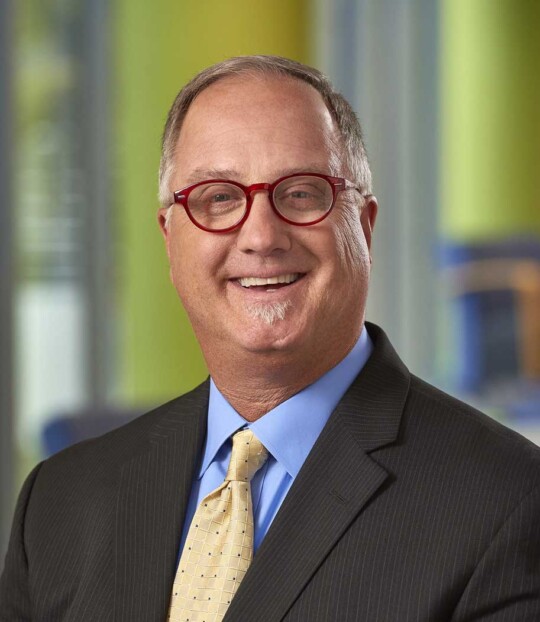
Bill Tomala, ICSC Government Relations Chair for Florida
I joined ICSC 15 years ago and I am fortunate to work for a company whose co-founding leader, Lonnie Peterson, understood the importance of joining ICSC. As a long-time ICSC volunteer, Lonnie also recognized the value of becoming involved with the organization. A testament to this is the University of Florida Lonnie G. Peterson Scholarship in Architecture that ICSC offers. Lonnie was my mentor, and there wasn’t a person who didn’t know him. He is the reason I became involved in government relations as he would often say, “Because policy affects our industry.” I started out volunteering and serving on Florida’s GR committee and attending ICSC’s “Day at the Capitol,” where I saw how policy could impact our industry, and I’ve been hooked ever since. I now serve as the ICSC Government Relations Chair for Florida and as Florida’s Marketplace Council member.
What is your favorite hidden gem in Florida that most people don’t know about?
Hmmm, this is a great question because I live in Florida, where there’s lots to do! Beaches and theme parks, what more could one ask for – right? I guess I’d have to go with The Skunk Ape Headquarters. It’s a roadside attraction dedicated to the elusive Skunk Ape, Florida’s version of Bigfoot, or the Sasquatch of the Southeast. It’s located in the middle of nowhere, in a place known as Ochopee, FL, right in the heart of the Everglades. Seriously, I can’t make this stuff up!
Which ICSC meeting is your favorite to attend?
Absolutely, without a doubt, I would say my favorite meeting to attend is the ICSC Federal Fly-In in Washington, DC. It’s a power-packed, non-stop, two-day, behind-the-scenes event. Day one is filled with meetings, updates, and various speakers discussing current legislation and policies directly affecting our industry on a national level. As if that weren’t enough, the second day is packed with over 150 face-to-face lobbying meetings with legislators—both House and Senate members—who represent ICSC members’ specific geographical areas. All of this is coordinated by ICSC staff, and all you need is a passion and a shared interest in seeing how our nation operates. The best part is you don’t need any experience in government, and you won’t be alone!
What is your favorite thing about the ICSC@FLORIDA Conference?
My favorite thing about ICSC@FLORIDA is the people and the social networking aspect. It’s more than just listening to panels and handing out your contact information. This event creates a great environment for forming valuable connections that may lead to future business opportunities. The fact is, no one’s going to turn you away if you walk up, smile, and say, “I’m so-and-so. Nice to meet you.” Every new person you meet has their own network, and I’ve found that by attending this event and focusing more on what I can bring to the conversation, rather than what I can gain from it, I experience more success. In addition to creating new connections, it’s always great to reconnect with the many long-lasting friendships formed over the years from attending this event. With ICSC, you truly get out of it what you put into it, and I wouldn’t be where I am in my professional career without my involvement in ICSC.
What is the best piece of advice you’ve ever received?
The best piece of advice I’ve ever received was often repeated to me by my grandfather. He would often say, “You know, it’s not what you know, and it’s not who you know…rather, it’s who knows you! So, if you’ve done a good job in life, then your name will be known in a good way, and your reputation as an individual will follow in a good way.” I often tell folks starting in commercial real estate and/or commercial development these words because our industry is a very small world. I give the scenario: You can name-drop all day long until you’re blue in the face; however, I may actually know the person you’re talking about. All it takes is for me to ask that person, “Hey, [insert name] was telling me they know you,” and they reply, “[insert name] who? Never heard of them!” Well, you’ve just created doubt and lost credibility. I try to live by these words both personally and professionally. I’d like to think that those who “know” me will say, “I know Bill Tomala, and he’s a straight talker who pulls no punches, tells you what you need to know, and not just what you want to hear. We can now make educated decisions!” If this holds true, then I guess I’ve done a good job in life.
Bill Tomala has served as the ICSC Government Relations Chair for Florida since 2019 and has been a member of the Florida Government Relations Committee since 2011.
About Cuhaci Peterson®
Cuhaci Peterson is a nationally recognized architecture, engineering and planning firm specializing in end-to-end commercial design solutions. Headquartered in Central Florida, the firm has representatives throughout the United States and is licensed in all 50 states. Cuhaci Peterson’s mission of transforming ideas into a value is enhanced by a staff of experts who collaborate with clients to translate visions into designs that elevate brands.
Kraig Koelsch
Manager, Marketing and Communications
407-661-9100
kraig.koelsch@c-p.com
Cuhaci Peterson Maitland (HQ)
Subscribe to our newsletter and get the latest news and updates
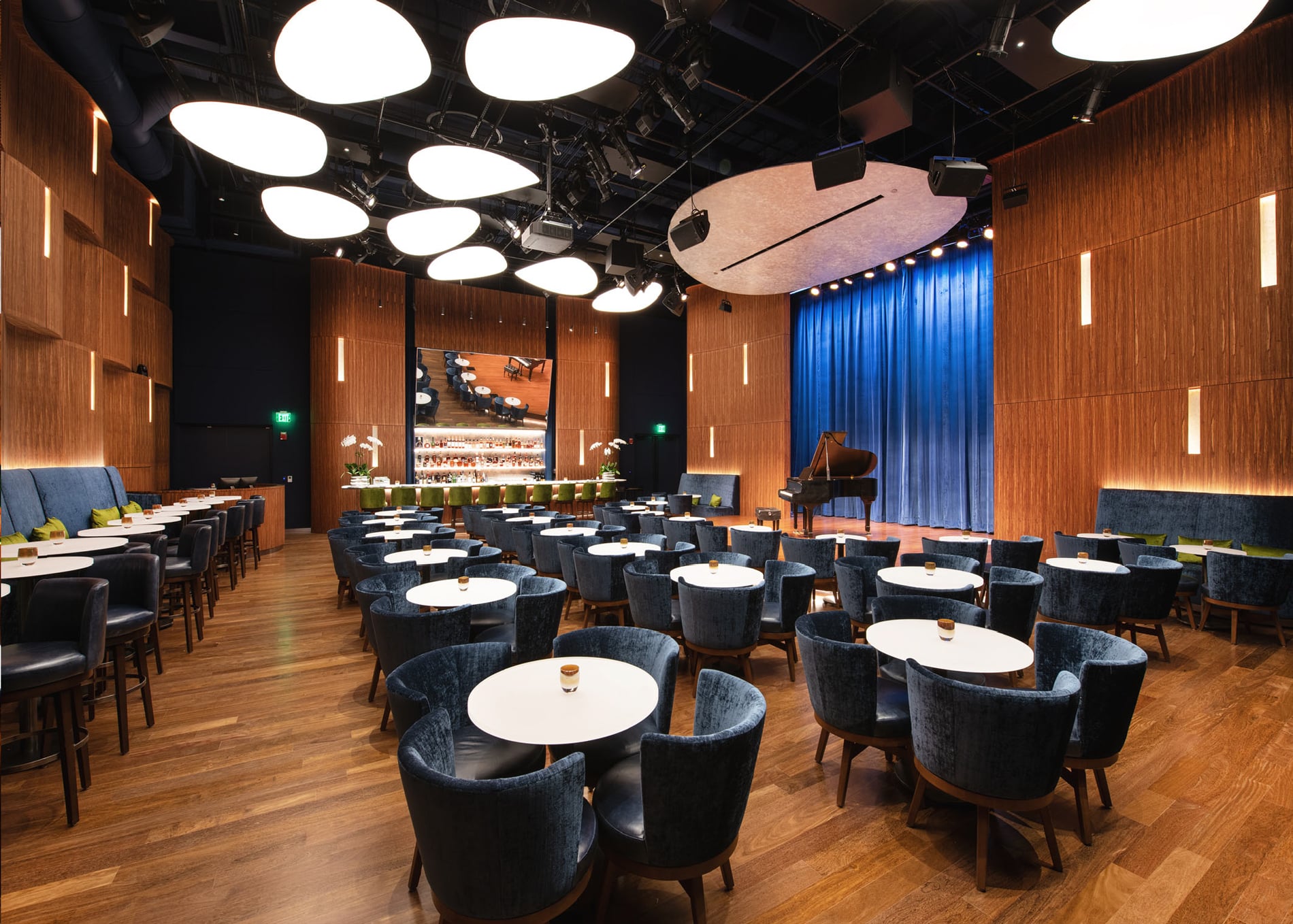
June 30, 2024

Every year architects and technical managers volunteer to judge projects whose construction is complete as part of the local Associated Builders and Contractors, Inc. chapter’s Excellence in Construction Awards program. One of the projects that Cuhaci Peterson was involved in judging this year is the newest space at the downtown Orlando Dr. Phillips Center for the Performing Arts, an interior build-out of the bottom floor.
While originally intended to be a rehearsal hall, Judson’s Live is another performance venue at the center providing a more intimate setting that also includes food and drink table service.
The room is fitted with acoustical wall paneling designed to enhance sound quality within the space while also adding to the aesthetic appeal of the space. Additionally, custom lighting was installed throughout the space including floating orb lights from Italy that can be controlled independently and change color as desired. A backlit stone bar countertop adds to the overall ambiance of elegance and class delivering a well-crafted finished product.
It was my honor to be asked to serve as a judge of this project and get the opportunity to visit the space and experience firsthand all the incredible aspects the room has to offer.
By Chris Renegar, Director of Architecture
About Cuhaci Peterson®
Cuhaci Peterson is a nationally recognized architecture, engineering and planning firm specializing in end-to-end commercial design solutions. Headquartered in Central Florida, the firm has representatives throughout the United States and is licensed in all 50 states. Cuhaci Peterson’s mission of transforming ideas into a value is enhanced by a staff of experts who collaborate with clients to translate visions into designs that elevate brands.
Kraig Koelsch
Manager, Marketing and Communications
407-661-9100
kraig.koelsch@c-p.com
Cuhaci Peterson Maitland (HQ)
Subscribe to our newsletter and get the latest news and updates
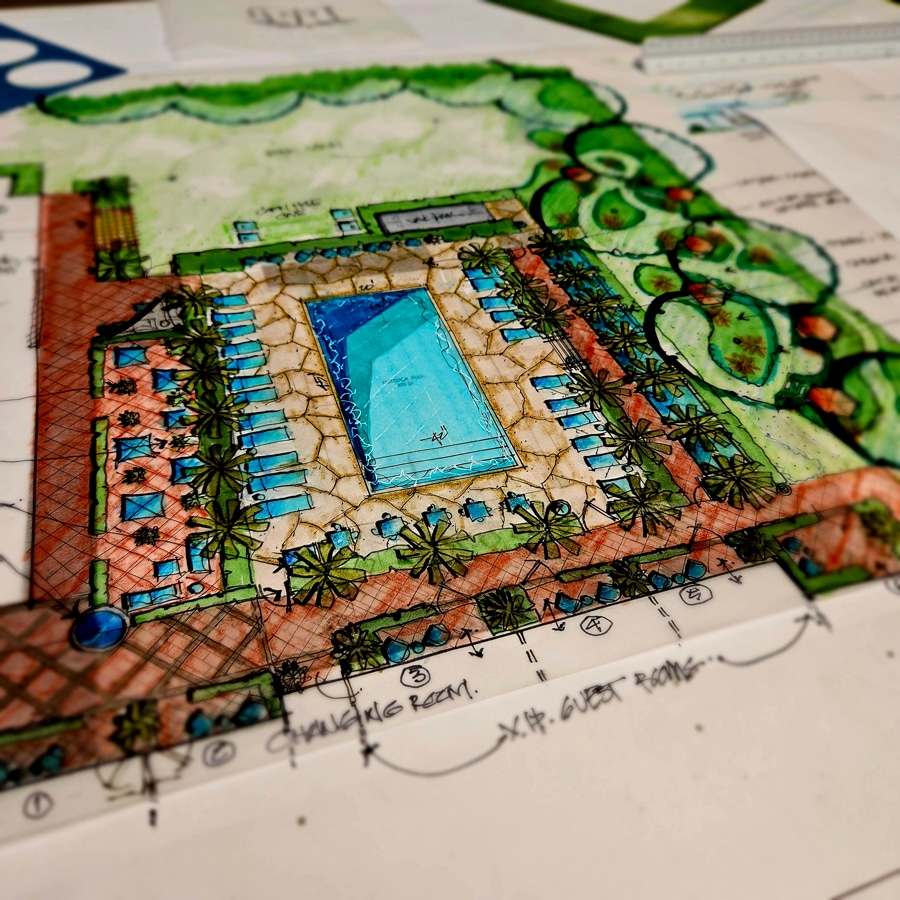
April 5, 2024
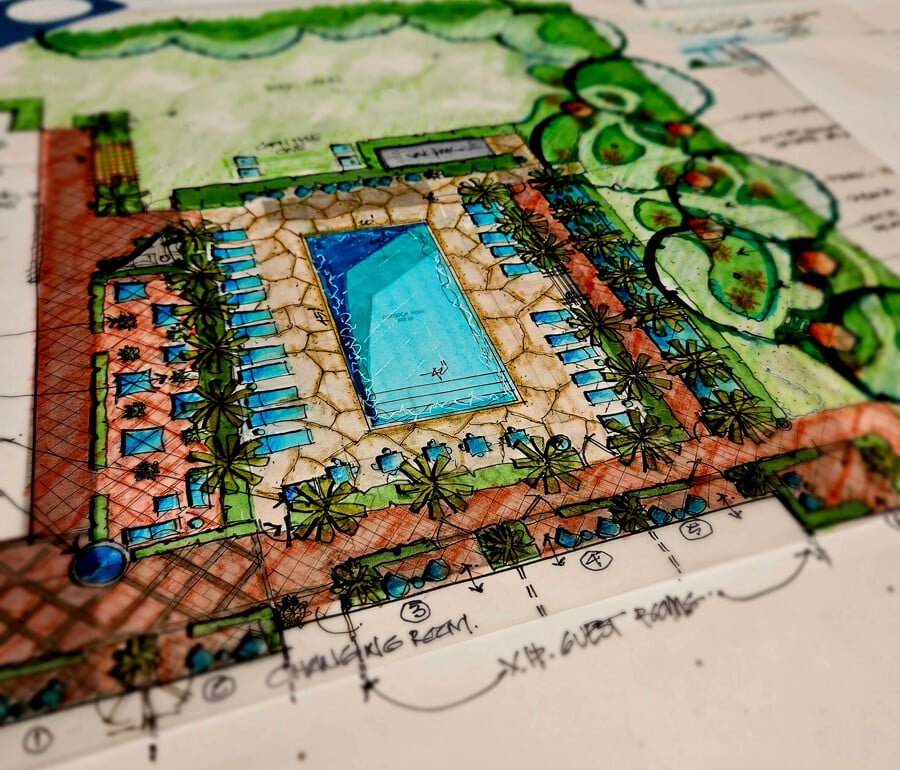
By Walter Bone, Landscape Architect
April is World Landscape Architecture Month (WLAM) and to celebrate, our Walter Bone, a licensed landscape architect, offers some insight into what it takes to succeed in this vital role.
Cuhaci Peterson is a multidisciplinary firm, and I am the lone landscape architect. We’re in our multi-team, multidisciplinary environment. We approach projects the same way per our corporate policy, but with the different professions. As a landscape architect, I look at projects a little bit different regarding building architects, engineers, interior designers and other design professionals. I look at projects with a design approach where I can take care of the environment. I want to be sensitive to the environment, preserving any natural resources that are there, and particularly wetlands, forested areas, tree preservation, et cetera. I look to minimize the disturbance to the wildlife as well.
So, it’s genuinely nice to work on projects where I can approach a project in that manner, a small little gas station or a small little restaurant drive thru. It’s very nice to approach the projects with a sustainable, more nature-based design where we can use some recycled materials, we can use wildlife enhancement, plant material, water features, et cetera. So, it’s nice to incorporate that natural design.
"I've enjoyed my career and most of my projects very much and my work is still extremely exciting and extremely rewarding to me."
Walter BoneLandscape Architect
It’s critical for landscape architects to be involved with each project from the very beginning. When the developer purchases a piece of land, we need to go out and do site visits and do a site survey, a visual site survey, take pictures, photographs, and note all the various elements, and physical elements that are existing on the site. Again, going back to our design approach, some of it is nature-based of course, but looking for critical elements such as wetlands, water, features, creeks, and streams, that we will not disturb, we’ll take notes, we will confer with other disciplines on the design team and note where we need to protect, note where we will enhance and increase the overall value of the property and project.
With that site analysis, we move into a concept design, considering all the elements that we’ve noted on the site. And with our picture taking, we’ll develop a report, a drawing, showing the site analysis and all the critical elements that affect the site, both on and offsite. Those would include environmental, sun, winds, various times of the year, seasonal effects, water sources, whether it be natural storm water, drainage solutions or municipal supplied water. And we take all these elements into effect in coming up with our concept design and working closely with the client to ensure that their design intent, what they envision comes to life.
Our creative design process starts with the client’s needs and the end results they’re looking for. After the initial concept site analysis is done, we move into a bubble diagram or a land use relationship and examine how different parts of the site, various parts of the project come together and how they relate to one another. And with that, the design will start appearing and you will see how the different areas, or the different uses relate to one another and how they interact with one another. And this will influence the pedestrian circulation and vehicle circulation of the project depending on project type. So it’s very clear as you’re going through the design process from your initial analysis into concept design schematic and so forth, that as the process is developing and you’re creating the concept design, you have all these other elements with the pre-work that was performed and research you have done, and it really comes to life.
You can see it coming out of the paper while you’re sketching, you’re drawing. It really starts developing itself, becoming its own life form. The design process and getting to that point is just a matter of doing a lot of hand sketches layer upon layer upon layer of sketch paper. And it’s really a very cool process to go through, creating and coming up with the concept and then ultimately presenting it to the client and getting their reaction. When you see a smile on their face, it’s wonderful and you’ve achieved what you started out to do. And so, when you get through that concept phase, there may be a few comments and a few little tweaks and adjustments here and there, but it’s fantastic and it’s a great learning experience as well. Regardless of how old you might be, you still learn from project to project.
The built form or the man-made form is critical as well. And so, working with building architects and the built environment, it is very, very intriguing to me as a landscape architect. As a designer, I want my landscape or my outdoor environment to blend with the interiors and with the materials of the building, the architecture, the design itself, the structure where I want to take the outdoors and bring it in or the indoors and bring it out through the use of color, texture, materials, repetition and the theming as well.
So, I use the materials by repeating them through the landscape which may have wood and I may take that same wood and use it through site furnishings, park benches, trash receptacles, small bridges over water features or what have you. It’s just a fantastic process in collaborating with other disciplines. Here at CP when we’re brainstorming, we’re throwing ideas out, we have our tracing paper and we’re going layer upon layer upon layer of unique design ideas and coming up with that fantastic design. So, collaborating closely with the designers or the discipline of the built environment is extremely critical in the success of my work or my team’s work for the landscape architecture aspect of the project.
Projects come alive, and again, it goes back to the inspiration, the creativity or the creative phase initially during your site analysis and moving into concept and bringing projects alive. I always prefer to create a wow effect when a person arrives to the project, regardless of the project type. It could be a public park, it could be a theme park, a water park, it could be a school, it could be an office building, but creating that wow effect, or some may call it small curb appeal, but I want more than just a curb appeal. I want to create a wow effect. When people arrive to whatever the project may be, I want them to go, wow, look at this. This is fantastic. And we have so much fun on our multidisciplinary design teams here that one person brings up an idea, another one brings up another idea, and we combine everyone’s ideas together and we all stand back and go, wow, this is fantastic.
And we’re so eager to go meet with the client. We’re ready to go see the client and sit down with them, have dinner with them, and present the idea. That’s how excited we get. So, bringing the project alive, it is really many facets to getting to that point and achieving the design goals and the income goals by the client. Creating that wow effect or other elements within the design to make it come alive is critical and very, very important to have these organized thoughts arranged in a cohesive manner on the drawing board and really have it all culminate into one big grand design and with the wow effect upon the guest or the customer’s arrival is really critical in the success of the project.
Giving a building personality, whether it’s during the daytime or nighttime, you will have significant design effects and viewpoints on your project. And creating both a cohesive building or structure and landscape design that complement one another and creating the various effects that can be achieved through lighting, planting, shade and shadow effects. Creating texture with the architecture and with the landscape is just fantastic. And with our design approach, we really look at buildings, not only just at the daytime model or with the sunshine midday, but we look at it at different times of the day and different times of the year where the building structure itself will take on different personalities based on sun angles, night lighting, parking lot, lighting, accent lighting up, architectural feature lighting, landscape lighting up or down lighting and trees and so forth, which we can really create a very, not exotic, but a very dramatic effect on the building day and night.
Our design process is very collaborative. We have constant meetings, most of the time in person. We say, come on, let’s go! We jump on a conference table; we lay out the drawings or do markups. Everybody comes to an agreement, then everybody separates, goes back to their stations and continues to work on the design. We also have, with our other offices, Teams meetings where we will collaborate on the design and ensure that one office may be producing or responsible for production.
So, we ensure that the design integrity is maintained amongst all disciplines to make the client happy and be consistent and minimize costs during construction as well. So, we are extremely collaborative through the drawing review process. We have folks who have not worked on the projects reviewing the drawings and looking at details, our layout and dimensioning grading and drainage, everything that we work.
Myself as a landscape architect and area development manager, I look at all the utilities, architectural, structural foundations, footings, utilities, and I coordinate everything. There will not be any issues when it comes to construction where there’s not going to be any conflicts where they must go back and dig up and redo work. So, looking at different elevations underground, making sure the pipes and utilities, there’s not any conflicts. We have our proper pressure lines that are not conflicting with any drainage, other drainage lines and so forth.
I’ve been fortunate to see a lot of places and do so many different projects in my professional career, which has spanned 35 plus years, coming up on 36 in a couple of months. I’ve lived around the U.S. and worked from the west coast to the east coast, Midwest, southeast, southwest. And growing up, I even lived in Mexico City for a couple of years.
There are so many different experiences and projects that it would take a long time to list them all out, but I can tell you with great certainty, I’ve enjoyed my career and most of my projects very much and my work is still extremely exciting and extremely rewarding to me.
World Landscape Architecture Month let’s folks know that it’s not only just a profession or professional month dedicated to our professional landscape architecture, but it also takes on a different meaning to many different people in the related professions. So, with April being the beginning of spring, depending on where you live, flowers are starting to bloom. April is an ideal time to hold landscape architecture month. It’s a rebirth, a renewal of life as everything’s blooming. Leaves are growing back on trees again, depending on where you live.
But the professional landscape architecture has meant so much to me throughout my career, that having a month celebrating our profession is just fantastic. Of course, I do it throughout the year, but I also look to donate time to assist and educate the general public, children’s classes, whatever I can do to teach folks or allow them to pick up and learn what landscape architecture is and see if I can slowly or nudge a little bit to see if they would like to become a landscape architect.
It’s a fun discipline and you have a fun time. It’s extremely fulfilling to see people, the general public, enjoy your spaces, whether it be a public park, a schoolyard, a large urban plaza, streetscapes, a golf course, or whatever we may design. To see people and experience what they’re experiencing for the first time and enjoying the spaces that we design is, well, it’s perfect!
About Cuhaci Peterson®
Cuhaci Peterson is a nationally recognized architecture, engineering and planning firm specializing in end-to-end commercial design solutions. Headquartered in Central Florida, the firm has representatives throughout the United States and is licensed in all 50 states. Cuhaci Peterson’s mission of transforming ideas into a value is enhanced by a staff of experts who collaborate with clients to translate visions into designs that elevate brands.
Kraig Koelsch
Manager, Marketing and Communications
407-661-9100
kraig.koelsch@c-p.com
Cuhaci Peterson Maitland (HQ)
Subscribe to our newsletter and get the latest news and updates

March 6, 2024
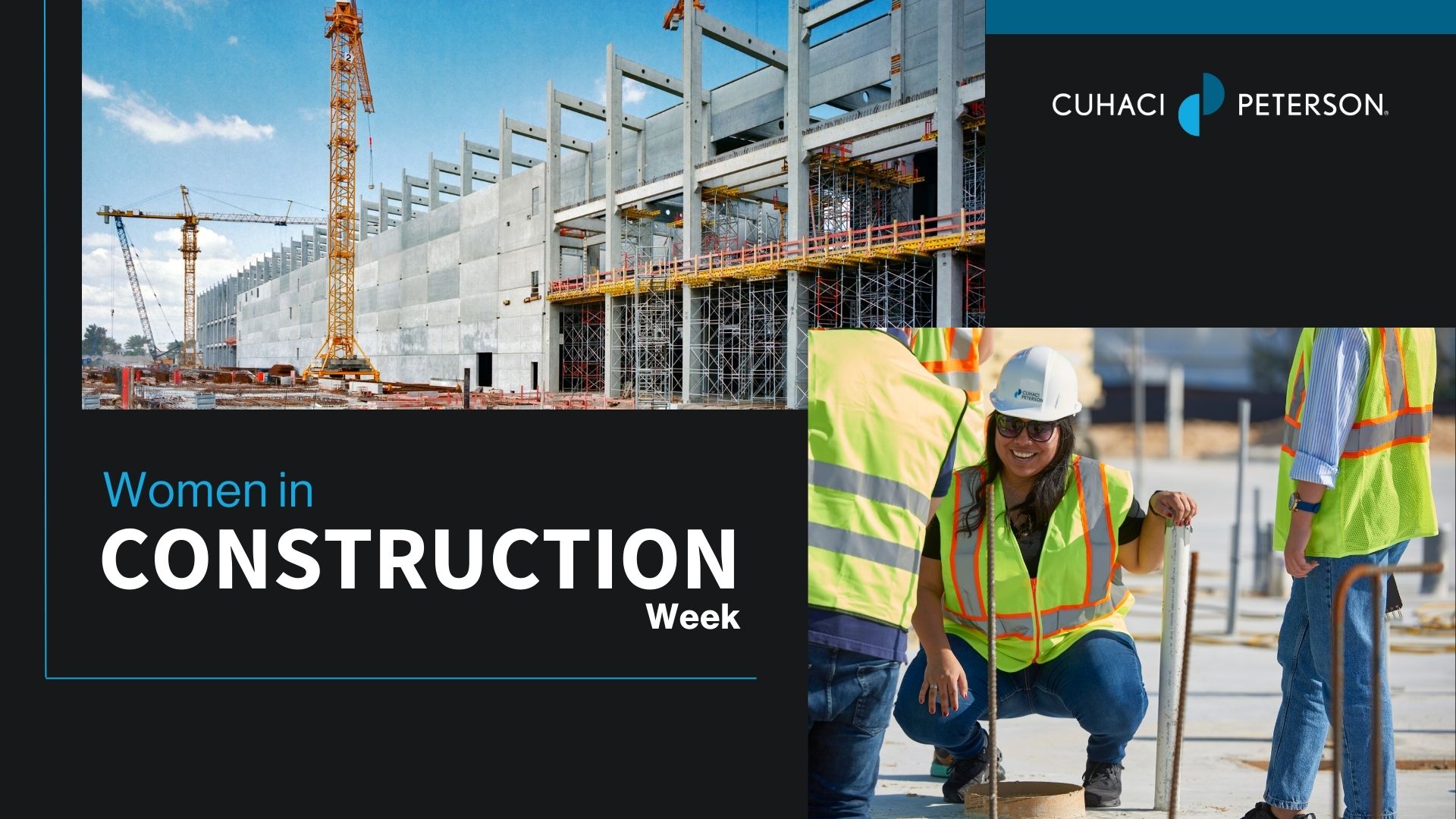
In a world where hard hats and steel-toed boots are often associated with men, Women in Construction Week (WIC Week) recognizes and celebrates the vital contributions of women in the construction industry. Since its inception by the National Association of Women in Construction (NAWIC) in 1998, WIC Week has embodied a collective commitment to fostering inclusivity and providing women with the resources and community needed to thrive in construction roles.
As more women venture into construction roles, they contribute a fresh perspective, fostering innovation, and driving problem-solving to new heights. Their presence not only addresses the industry’s skills gap but also champions a more inclusive and dynamic workforce, enriching teams, organizations and society. This year’s theme, ‘Keys to the Future’, fosters awareness and emphasizes the pivotal role of women in shaping the trajectory of the construction landscape.
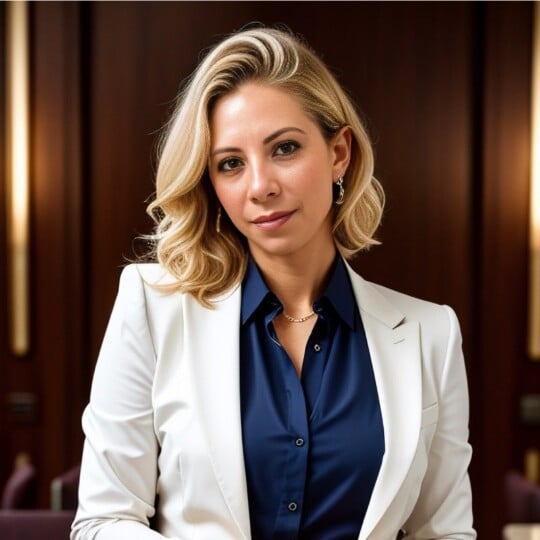
Angelica Corredor
Senior Project Manager
This year, we spoke with Angelica Corredor, a Senior Project Manager in our Orlando office to gain more insight into her experience in the architecture, engineering and construction (AEC) industry. Her involvement on the board of Women in Architecture (WIA) Orlando has helped her in growing both her professional and personal skills and made her a great candidate to share her knowledge with younger women looking to join the industry.
About Cuhaci Peterson®
Cuhaci Peterson is a nationally recognized architecture, engineering and planning firm specializing in end-to-end commercial design solutions. Headquartered in Central Florida, the firm has representatives throughout the United States and is licensed in all 50 states. Cuhaci Peterson’s mission of transforming ideas into a value is enhanced by a staff of experts who collaborate with clients to translate visions into designs that elevate brands.
Kraig Koelsch
Manager, Marketing and Communications
407-661-9100
kraig.koelsch@c-p.com
Cuhaci Peterson Maitland (HQ)
Subscribe to our newsletter and get the latest news and updates
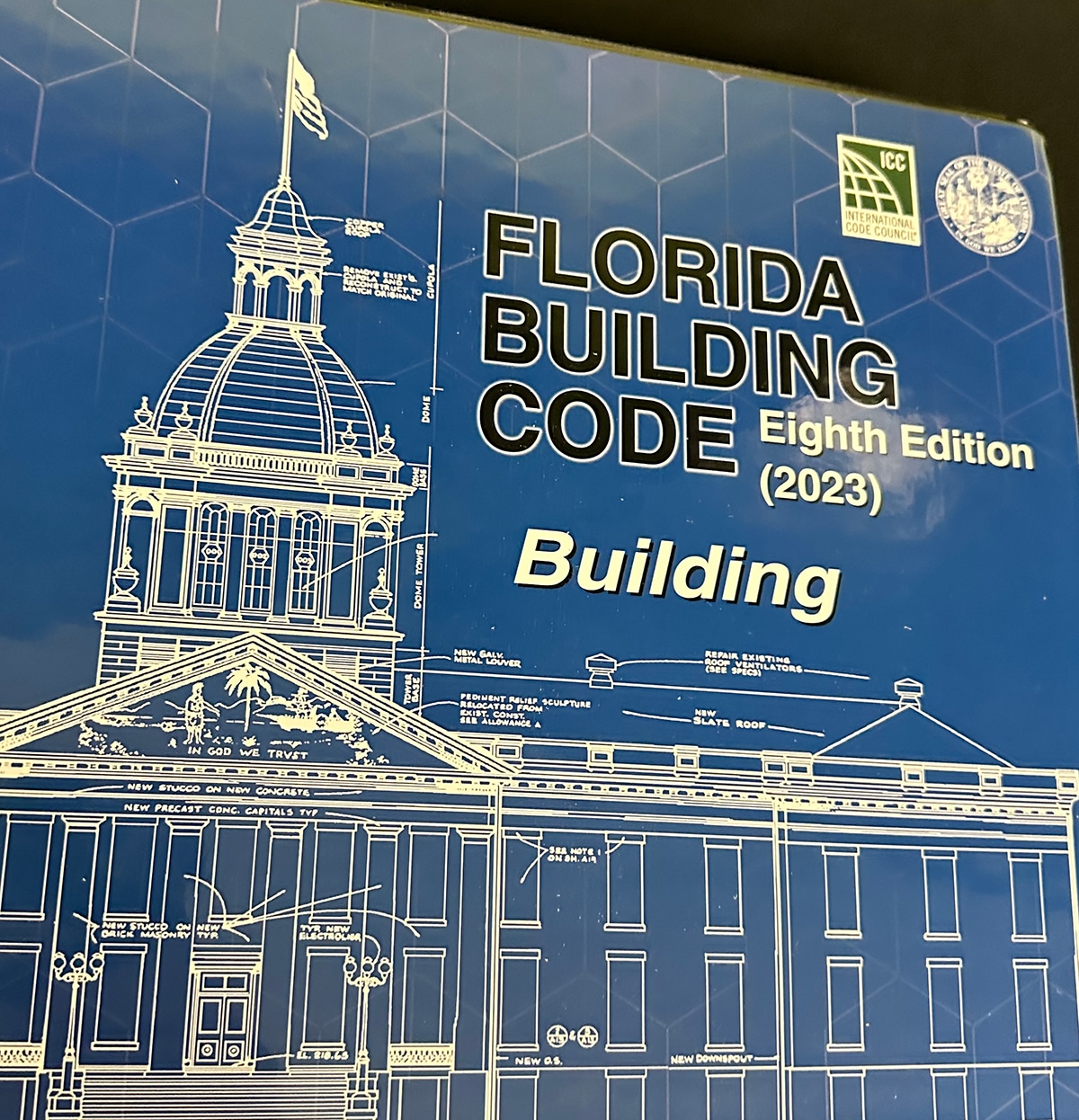
January 26, 2024
As we welcome the new year, we are also looking to start a new Florida Building Code (FBC) cycle. Effective January 1, 2024, the 8th Edition or 2023 FBC took effect. That means any project submitted to a jurisdiction in the State of Florida on or after this date (Jan. 1, 2024) will have to conform to the new 2024 code.
Of course, as with anything new or revised, there are changes associated between the new code (2023) and the previous version (2020). As such, we at Cuhaci Peterson are always on the lookout for changes that impact project scope and/or create additional costs for our business and potentially, our clients.
One area we frequently encounter when either designing new retail buildings or dealing with existing facilities, involves changing tenants that, due to the nature of their business and operation, may present a change in use and occupancy for the applicable space and/or building.
Touching on this issue, one of the changes in the new code is found in Chapter 2 “Definitions” of the FBC where a revision was made to the definition for the term, “Change of Occupancy.”
The previous version framed the definition in terms of “a change in the use of a building or portion of a building” while the latest version talks about “any change in the purpose or level of activity.” Therefore, a new tenant’s purpose, or goal in their business and/or operation of a building or portion thereof, could potentially result in a change in the occupancy type and/or group within an occupancy type.
This in turn could result in requirements for “a greater degree of safety, accessibility, structural strength, fire protection, means of egress, ventilation or sanitation than is existing in the current building or structure.”
Thus, this gives building officials greater latitude to determine if any changes in occupancy classification, and subsequent building upgrades, are mandated based on the proposed purpose or applicable change in level of activity represented by the new tenant.
You can identify all the changes in the new code version from the previous one by visiting the Florida Department of Business & Professional Regulation’s website as revisions can be identified by their red font color.
By Chris Renegar, Director of Architecture
About Cuhaci Peterson®
Cuhaci Peterson is a nationally recognized architecture, engineering and planning firm specializing in end-to-end commercial design solutions. Headquartered in Central Florida, the firm has representatives throughout the United States and is licensed in all 50 states. Cuhaci Peterson’s mission of transforming ideas into a value is enhanced by a staff of experts who collaborate with clients to translate visions into designs that elevate brands.
Kraig Koelsch
Manager, Marketing and Communications
407-661-9100
kraig.koelsch@c-p.com
Cuhaci Peterson Maitland (HQ)
Subscribe to our newsletter and get the latest news and updates
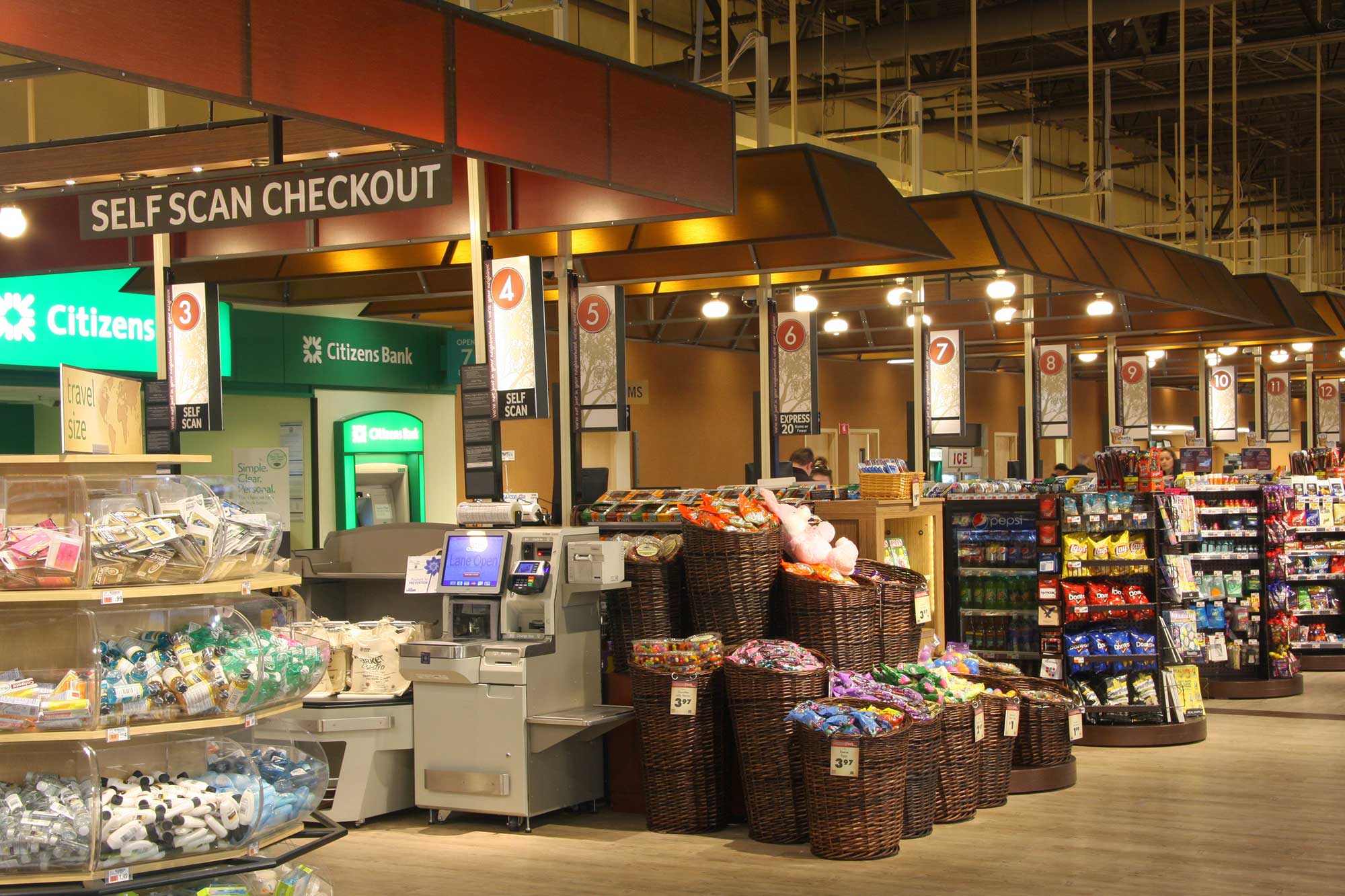
December 18, 2023
Cuhaci Peterson’s Senior Vice President of Design, Steven Duffy, was interviewed in the December 14th issue of Progressive Grocer, examining the topic of The Future of Retail: Unpacking Innovative Front End Strategies.
While acknowledging the importance of a seamless checkout process, Duffy cautions that “not all shoppers are looking to breeze in and out frictionlessly. While consumer appetites have grown to become less tolerant of waiting in line, some (more senior) shoppers seek the social interaction of the checkout process.
Grocers must also account for loss prevention and shrink technologies when enabling frictionless front ends. Optimized examples depend on format and are also commensurate with the retailers’ DNA. Are they a value operator, middle of the road or more of a premium brand?” Duffy added.
According to Duffy: “Savvy retailers seek to secure that last sale in line with well-curated impulse items, typically composed by a visual merchandiser. Grocers should consider using displays that illuminate and highlight specialty or must-have items, and products should also be a mix of seasonal or local offers.”
Getting shoppers to really notice the products featured in the front end can also give rise to opportunities for nontraditional items beyond the usual candy, snacks, magazines and soft drinks.
To read the entire article you may do so on the Progressive Grocer website by clicking here.
About Cuhaci Peterson®
Cuhaci Peterson is a nationally recognized architecture, engineering and planning firm specializing in end-to-end commercial design solutions. Headquartered in Central Florida, the firm has representatives throughout the United States and is licensed in all 50 states. Cuhaci Peterson’s mission of transforming ideas into a value is enhanced by a staff of experts who collaborate with clients to translate visions into designs that elevate brands.
Kraig Koelsch
Manager, Marketing and Communications
407-661-9100
kraig.koelsch@c-p.com
Cuhaci Peterson Maitland (HQ)
Subscribe to our newsletter and get the latest news and updates
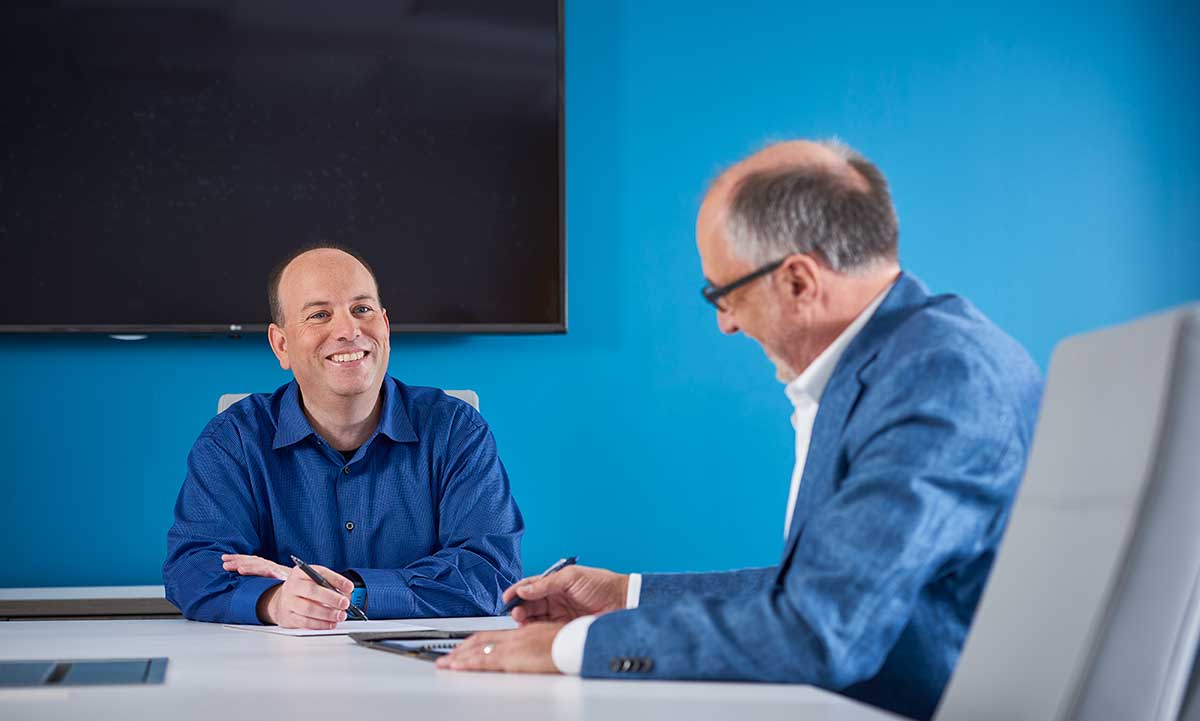
October 24, 2023
When most people start their first internship, they don’t expect to become the Chief Operating Officer of the firm 20 years later. For Josh Inman, his path at Cuhaci Peterson brought him a myriad of opportunities, shaping him into the architect he aspired to be since high school.
It all started when his family moved to West Lafayette, Indiana, during his sophomore year of high school. Amidst the chaos of building their new home, his parents needed a design for a two-story vaulted wall. Unimpressed with the builder’s proposal, Josh took matters into his own hands, hand-drawing brick designs for the focal point of the wall. After hours of sketching and many iterations, he presented the design to his parents at 1:30 a.m. His design materialized weeks later, solidifying his determination to pursue architecture. Subsequently, he continued to enhance the house, contributing designs for a deck and incorporating tile features within the interior.
His last two years in high school saw him navigating towards a college that would propel him into an architectural career. Despite a life-long dream to attend the University of Florida, Josh chose Ball State in Muncie, IN.
“The five years at Ball State were some of the most influential years of my entire life and have shaped not only who I am as an architect, but really who I am and what I’m about as a person,” said Inman. “It turned out to be one of the greatest decisions I’ve ever made in my life,” he added.
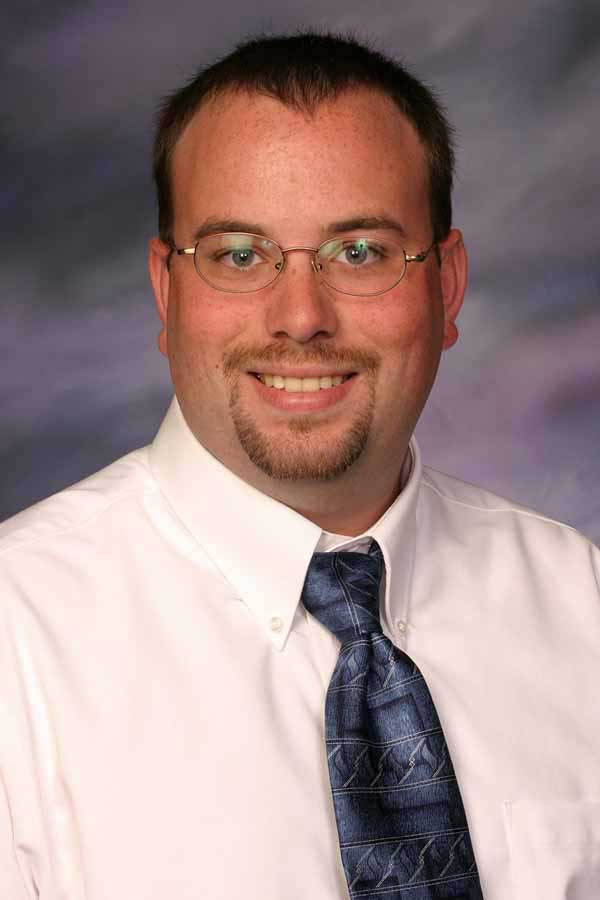
Entering Ball State’s five-year architecture program mandated an internship before graduation. After facing challenges securing positions in Indiana and Chicago, IL, Josh attended a job fair where he encountered Greg Simpson, who served as studio director at Cuhaci Peterson at the time. Simpson presented an opportunity at the firm’s Florida headquarters, offering accommodations in exchange for Josh’s commitment to work. Accepting the internship, he spent a semester at CP before returning to Ball State to complete his degree.
Post-graduation, the job market’s challenges led Josh to call Cuhaci Peterson asking if they had any job opportunities. Six weeks later, Josh was back in Florida working at CP. What he expected to be a two or three-year stint turned into a long-term commitment as Josh is now looking back at more than 19 years at the firm. “Something about Cuhaci Peterson just felt right. One of the things I love about CP is that I’m free to take risks and try new things,” Inman stated.

Beginning as an architectural graduate, Josh collaborated on retail, grocery, church and mixed-use projects. His affinity for challenging aspects of projects and a collaborative spirit with colleagues like Kevin Payne and Nathan Griffis fueled his career growth. Within the first couple of years, he began to see a strong career growth trajectory for himself. Josh recalls leaving a meeting as a project coordinator thinking “I could see myself running this office… is there really anything to stop me?” Engaging with leaders at the firm, he advocated for breaking down vertical tracks within the organization, emphasizing the possibility of moving laterally between technical, project management, sales and executive roles.
Recognizing the benefits of a business degree to lead the company, he pursued a master’s program at the University of Florida’s College of Business simultaneously fulfilling his dream of earning a degree from UF. Throughout his master’s program, he took classes based on his ambitions at Cuhaci Peterson. This reinforced Josh’s belief of the transformative power of education. “It absolutely changes who we are and betters us, even if we don’t use it right away,” said Inman. “My MBA has paid for itself many times over in the past five and a half years,” he added.
While serving as the Director of Operations, Josh steered through substantial hurdles, such as the pandemic, hurricanes and downsizing. Despite the taxing nature of these challenges, overcoming them brought immense satisfaction. When discussing his role and duties, he underscored the collective significance of every individual in the organization. Building connections, nurturing the team, and surmounting obstacles are essential aspects of propelling the firm towards greater achievements. Josh ensures that each decision he makes considers not only the well-being of CP’s 250+ employees but also extends to their families.
Reflecting on his journey, Josh imparts advice to aspiring professionals: be confident, trust yourself and embrace new opportunities. At Cuhaci Peterson, no one will stand in your way if you’re seeking new opportunities or want to try new things. Our culture of support fosters individual growth, encouraging team members to pursue their passions.
About Cuhaci Peterson®
Cuhaci Peterson is a nationally recognized architecture, engineering and planning firm specializing in end-to-end commercial design solutions. Headquartered in Central Florida, the firm has representatives throughout the United States and is licensed in all 50 states. Cuhaci Peterson’s mission of transforming ideas into a value is enhanced by a staff of experts who collaborate with clients to translate visions into designs that elevate brands.
Kraig Koelsch
Manager, Marketing and Communications
407-661-9100
kraig.koelsch@c-p.com
Cuhaci Peterson Maitland (HQ)
Subscribe to our newsletter and get the latest news and updates
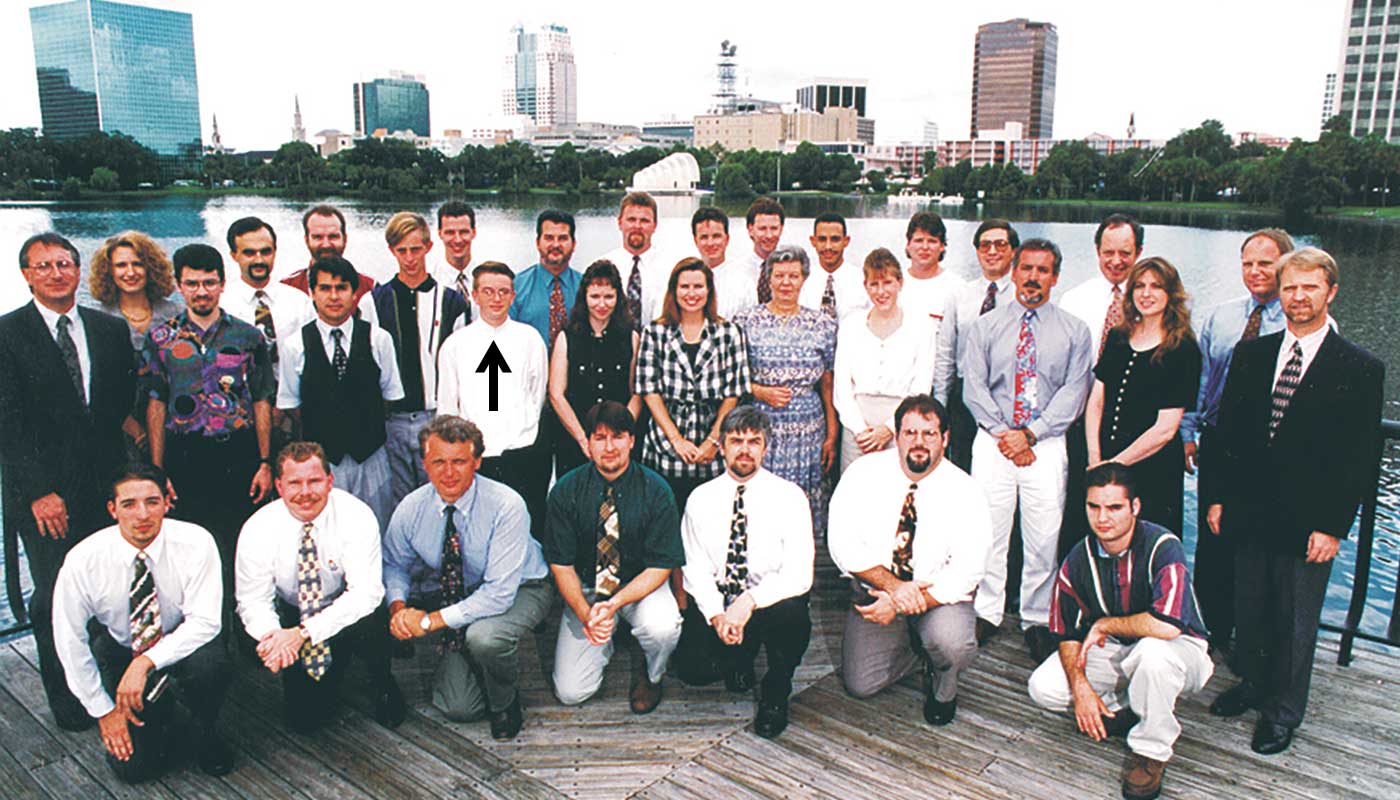
July 18, 2023

Daniel Lee’s path to his current position was not a conventional one. Through the Central Florida Council of the Boy Scouts, he got connected with Lonnie Peterson, the co-founder of Cuhaci Peterson. Attending a banquet for the Eagle Scouts, Daniel had the opportunity to meet Lonnie, which eventually led to an internship and a long-lasting connection.
Daniel’s integration into the company was rapid, thanks to his prior experience in high school CAD drafting. He started working on projects, gaining familiarity with the processes and gradually taking on more responsibilities. Although he started as an intern, he quickly learned and grew through asking questions and seeking guidance.
When Lee started working at CP, there was only a handful of employees and a single office. Fifteen years later, Cuhaci Peterson employs more than 250 staff members in multiple locations across the U.S. The familiarity and family-like atmosphere at CP, combined with the loyalty he felt from the company during challenging times is what has kept Danny at the firm. “[CP] saw something in me to keep me around. There’s something there that they value, so I feel like it’s a good place to stay… You feel appreciated,” Lee stated.
Daniel explained that despite the changes that have occurred as Cuhaci Peterson expands and transforms into a more corporate entity, our growth was strategic. “We’ve strategically positioned people and offices across the U.S. to best serve our clients,” said Lee. Instead of haphazardly opening multiple offices, the firm considered the opportunities that arose and carefully expanded its presence. Additionally, he mentions the lessons learned from past experiences which helped improve collaboration and communication among different offices. CP’s ability to adapt and value input from employees contributes to continued success.
Throughout his tenure, Daniel has worked on various projects, including notable clients such as Winn-Dixie, Leslie’s Pool Supplies, Miller’s Ale House and The Habit Burger Grill. These projects have allowed him to gain diverse experience in various sectors of commercial architecture, contributing to his professional growth and expertise.
Reflecting on his own journey, Daniel offers advice for those considering a career in architecture. He suggests that aspiring architects consider interning at a firm before attending design school. While his experience provided valuable real-world insights, it also posed challenges when transitioning to the more imaginative and boundary-free environment of design school. Striking a balance between practical experience and creative exploration is crucial for success.
Daniel Lee’s journey from intern to technical manager at Cuhaci Peterson showcases loyalty, growth and the value of networking. Through diverse projects, he gained valuable expertise in in the architectural industry. His advice to aspiring architects emphasizes the balance between practical experience and creative exploration. Daniel’s story highlights the rewards of embracing unconventional paths and seizing opportunities along the way.
About Cuhaci Peterson®
Cuhaci Peterson is a nationally recognized architecture, engineering and planning firm specializing in end-to-end commercial design solutions. Headquartered in Central Florida, the firm has representatives throughout the United States and is licensed in all 50 states. Cuhaci Peterson’s mission of transforming ideas into a value is enhanced by a staff of experts who collaborate with clients to translate visions into designs that elevate brands.
Kraig Koelsch
Manager, Marketing and Communications
407-661-9100
kraig.koelsch@c-p.com
Cuhaci Peterson Maitland (HQ)
Subscribe to our newsletter and get the latest news and updates
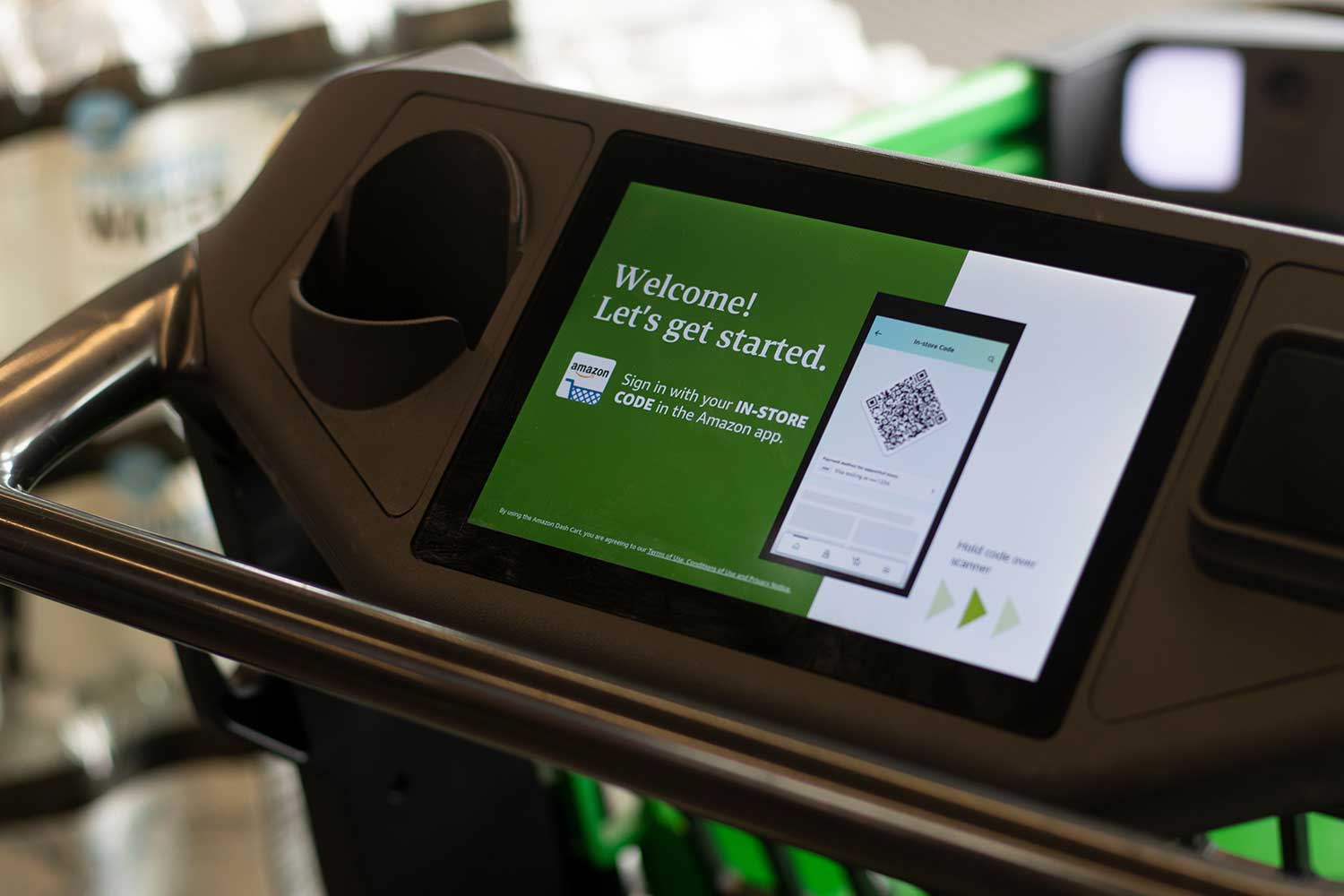
June 1, 2023
Store sizes are changing, remodeling activity is on the rise and selling space is under pressure from alternative uses. This is the format-flexible world in which merchants must make optimal assortment decisions to satisfy shoppers and grow sales. Doing so requires understanding where store design is headed, the impact on selling space and how assortment optimization enables new opportunities.
Improve your understanding of these new dynamics by joining Steven Duffy, SVP of Design with the acclaimed architectural, engineering and design innovation firm Cuhaci Peterson, and Todd McCourtie, VP of Product Management Assortment and Space Planning, at SymphonyAI Retail CPG, for a revealing look at: Hot store design trends, remodeling innovation and what’s next for small formats. How assortment optimization enables design flexibility and productivity improvement.
The role of advanced technologies in understanding new item incrementality, transferable demand and store clustering opportunities. Practical examples of how AI improves the speed and accuracy of merchants’ optimization efforts.
To download the on-demand recording, please click here.
About Cuhaci Peterson®
Cuhaci Peterson is a nationally recognized architecture, engineering and planning firm specializing in end-to-end commercial design solutions. Headquartered in Central Florida, the firm has representatives throughout the United States and is licensed in all 50 states. Cuhaci Peterson’s mission of transforming ideas into a value is enhanced by a staff of experts who collaborate with clients to translate visions into designs that elevate brands.
Kraig Koelsch
Manager, Marketing and Communications
407-661-9100
kraig.koelsch@c-p.com
Cuhaci Peterson Maitland (HQ)
Subscribe to our newsletter and get the latest news and updates

April 20, 2023
Assortment optimization has been fundamental to retail success and store design since retail began. Even the earliest merchants understood this millennia ago when they sought to offer the optimal mix of products with the highest probability of producing profitable sales growth. The goal is the same today but advances in technology and adoption of AI have transformed how retailers leverage increasing volumes of data to make precise assortment optimization decisions that increase the productivity of selling space. This ability means retailers can think differently about growth opportunities, store sizes, results-oriented remodeling activities, and the allocation of space in stores. When it is possible to optimize assortments and improve productivity, a wide range of other growth-related decisions are affected.
Join Cuchaci Peterson’s Senior President of Design, Steven M. Duffy, and SymphonyAI Retail CPG’s Todd McCourtie, Vice President, Product Management Assortment & Space Planning, who will be featured on a free webinar where they will participate in a group discussion titled, “Merchandising Success in a Format-Flexible World.”
The panel will discuss store design trends and innovation, synergies with assortment optimization and how to deploy advanced #AI technologies for deeper insights.
About Cuhaci Peterson®
Cuhaci Peterson is a nationally recognized architecture, engineering and planning firm specializing in end-to-end commercial design solutions. Headquartered in Central Florida, the firm has representatives throughout the United States and is licensed in all 50 states. Cuhaci Peterson’s mission of transforming ideas into a value is enhanced by a staff of experts who collaborate with clients to translate visions into designs that elevate brands.
Kraig Koelsch
Manager, Marketing and Communications
407-661-9100
kraig.koelsch@c-p.com
Cuhaci Peterson Maitland (HQ)
Subscribe to our newsletter and get the latest news and updates

April 11, 2023
As labor costs and materials continue to rise, some grocers are looking at used equipment to get them through this latest phase of uncertainty. However, a big issue remains; while used equipment can be a viable option, some will soon be obsolete, since old technologies are being phased out. And such equipment must comply with Department of Energy requirements.
As part of a recent interview for Progressive Grocer Magazine, our Senior Vice President of Design, Steven Duffy, had a chance to address these issues and more as part of an expert discussion.
To continue reading, click here.
About Cuhaci Peterson®
Cuhaci Peterson is a nationally recognized architecture, engineering and planning firm specializing in end-to-end commercial design solutions. Headquartered in Central Florida, the firm has representatives throughout the United States and is licensed in all 50 states. Cuhaci Peterson’s mission of transforming ideas into a value is enhanced by a staff of experts who collaborate with clients to translate visions into designs that elevate brands.
Kraig Koelsch
Manager, Marketing and Communications
407-661-9100
kraig.koelsch@c-p.com
Cuhaci Peterson Maitland (HQ)
Subscribe to our newsletter and get the latest news and updates

July 25, 2022
An array of innovative security solutions is paving the way for reducing the incredible shrinking grocery story in a way that has its finger on the pulse of current and future trends, making grocers and retailers alike happy. When considering these security measures, we must do so holistically, with the store design in mind, realizing that it is a cost, a burden, and can cause friction on the shopping experience, but also poses a way out and a way forward. Shrink reduction in grocery and retail stores has usually been influenced by consumers, and a myriad of factors, among them product type, inventory count, store location and other factors. While loss prevention strategies have helped in the past, the current widely held view is that they’re trending negatively, especially when you factor in frictionless shopping and checkout.
Frictionless checkout, another alternative to store-based surveillance, is the ultimate surveillance state without feeling like cameras are watching your every move. If you’ve visited an Amazon Go store (and others), you have seen this in place, including their “just walk out” technology which is exactly as it sounds. You shop, scan your own items, pay with an app and away you go. But this also comes with risk and that can lead to negative variables like skewed inventory count, theft and more. Next, factor in facial recognition, which has made significant advancements worldwide, thanks to artificial intelligence and camera networks, but with this innovation comes consumer concerns regarding privacy and what data is being shared through a facial scan.
About Cuhaci Peterson®
Cuhaci Peterson is a nationally recognized architecture, engineering and planning firm specializing in end-to-end commercial design solutions. Headquartered in Central Florida, the firm has representatives throughout the United States and is licensed in all 50 states. Cuhaci Peterson’s mission of transforming ideas into a value is enhanced by a staff of experts who collaborate with clients to translate visions into designs that elevate brands.
Kraig Koelsch
Manager, Marketing and Communications
407-661-9100
kraig.koelsch@c-p.com
Cuhaci Peterson Maitland (HQ)
Subscribe to our newsletter and get the latest news and updates

April 21, 2023
By Chris Renegar, Director of Architecture
As we celebrate Earth Day 2022, we hear the words resiliency and sustainability a lot lately, especially when considering built environments. As Earth Day empathizes the need to focus on our environment and protecting our planet for a sustainable future, the idea of resilience in our built environment also contributes to a sustainable future. Resiliency and sustainability are part of evolving building and development codes that enhance our built environment. The shared attributes of resiliency and sustainability complement each other in several ways:
On August 23, 1992, I had no idea that a life-changing severe weather event would occur in less than 24 hours. At the time I was living in south Miami-Dade County, just north of the Florida Keys, in Florida City, a small town about 30 miles south of Miami. My house was 10 miles due east from Turkey Point Nuclear Generating Station that stands near the coast along Biscayne Bay, where the eye of Hurricane Andrew, a powerful and destructive category 5 storm, hit in the early hours the next day. While the house that I designed and built fared well before and after the eye of the storm passed over us, other houses and structures were less fortunate and suffered severe damage. One such house around the corner from where I lived, although built with concrete block walls, was blown away right down to the slab and block course at ground level.
The roofing system on the house I designed consisted of fiberglass shingles installed over building felt and a plywood sheathed roof deck fastened to wood roof trusses with a 7.5-in-12 pitch. The steep slope enabled the shingles on the roof to remain attached during the storm as the slope reduced the uplift pressures from the hurricane speed winds, a common result on most of the houses in my community where the typical roof pitch was 4-in-12. The only damage to the roof was a small skylight in the second-floor bathroom that was blown away. The rest of the house was undamaged. Across the street from an open field, the rocks picked up by storm winds broke all glass from windows without sufficient protection. Low-pitched roofs had roofing blown off down to the sheathing and, in some cases, the sheathing itself was torn off the trusses and blown away.
Besides the high winds, there were several equally, if even more destructive, tornados that were part of this event. The house next door to the one I designed, had an oak tree in the front yard twisted off the base of its trunk and was slammed against the adjacent gable end of the house. This opened the attic area and allowed high-speed hurricane force winds to blow in, uplift and remove the roof sheathing on this part of the house. The shingle roofing had already been blown off the roof.
In the days, weeks and months that followed we lived through a series of recovery efforts from initial triage response through martial law and occupation by military units to the rebuilding of the utility grid for the town. Some of my memories include the sound of generators humming in the neighborhood and the cold showers we took since we lacked the power to run our water heaters. While going through that type of experience makes you appreciate modern conveniences like electrical power and internet service, it also reminds us of the need to plan and be prepared for these types of events, which is part of the concept of resiliency in our built environment.
In 1995, I was part of a team that traveled to the U.S. Virgin Islands to help in the aftermath of Hurricane Marilyn. Working with Federal and Virgin Islands’ government agencies, we surveyed damaged schools and other buildings, including private retail centers that were rebuilding. One area of resilient planning from that experience was the importance of reestablishing operations in buildings damaged by the storm that were forced to close. Using resilient planning techniques, building operators and owners used contactors to repair damages on a “unit price” basis – per lineal foot, square foot, by the piece, etcetera – to expedite remedial construction, recovery and reopening of their facilities. While this approach is not always practical for small homeowners and commercial operations, it can be a game changer for the operations of the affected facilities when implementation is possible.
In the years since Hurricane Andrew hit Florida, increased levels of resiliency for the built environment have been implemented through new building codes and development requirements. Public buildings have even greater requirements, especially if designated as public shelters. Of course, code requirements are the minimum and the building owner/operator is encouraged to exceed these requirements when possible and practical. Along with the increased resiliency requirements in our building codes, a parallel implementation of increased sustainability has been implemented as part of building energy codes that have seen increased energy efficiency requirements. Starting in 1979, Florida energy codes have been a part of the building design process aiming to make our built environment more sustainable through energy conservation in both the static built-in elements, like building envelope materials, design and insulation, as well as operationally efficient through lighting, heating, cooling and water usage to name a few.
As government regulatory requirements enhance both the resiliency and sustainability of our built environment, other organizations such as the U.S. Green Building Council (USGBC) and Green Globes, encourage building owners and operators to focus on these three things:
That will hopefully leave the world a better place for our children than we found it.
About Cuhaci Peterson®
Cuhaci Peterson is a nationally recognized architecture, engineering and planning firm specializing in end-to-end commercial design solutions. Headquartered in Central Florida, the firm has representatives throughout the United States and is licensed in all 50 states. Cuhaci Peterson’s mission of transforming ideas into a value is enhanced by a staff of experts who collaborate with clients to translate visions into designs that elevate brands.
Kraig Koelsch
Manager, Marketing and Communications
407-661-9100
kraig.koelsch@c-p.com
Cuhaci Peterson Maitland (HQ)
Subscribe to our newsletter and get the latest news and updates
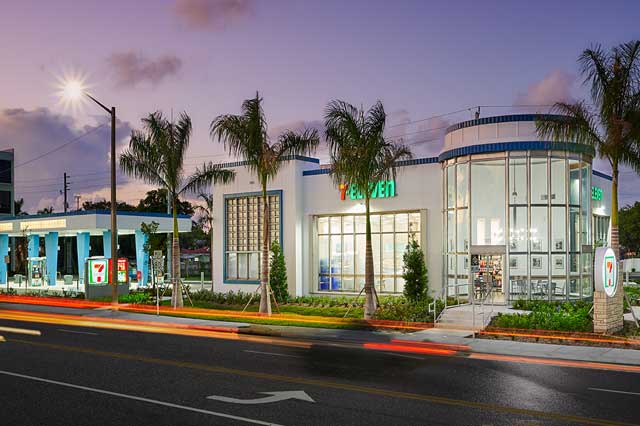
December 17, 2021
Old is now new again as 7-Eleven opened the doors to its latest convenience store located at the corner of Southern Boulevard and Olive Avenue in West Palm Beach, Florida with a spirited grand opening on December 16. But this isn’t your ordinary store as the building itself once housed a very popular area bank. The First Federal Savings and Loan building with its metal finishes and ample windows was admired as a “modernistic commercial” design with art deco flair when it opened near downtown West Palm Beach in 1959. The building has a large tower-like rotunda at one corner with floor-to-ceiling glass windows. It’s a conspicuous element to anyone driving to or from Palm Beach on Southern Blvd.
But in the past couple of decades, the building just over the bridge from well-heeled Palm Beach has worn down. Long emptied of its banking vestiges, the property has been too big, too small or just too unusual for any business to stay there long. But that’s where Cuhaci Peterson stepped in, leading production architecture efforts, mechanical, electrical and plumbing (MEP) systems as well as providing permitting services. Given the age of the structure, it provided plenty of opportunities for our team to solve problems, many of which were hidden.
Things you might not regularly consider when doing a new build, like making something new look old and having to deal with the local historical building society.
“The whole building from the interior had to be retrofitted, it had to be demolished and the basement had to be closed off as it didn’t meet any kind of fire code,” said CP Project Architect Wade Arnold. “We had to match the existing windows. The windows were diamond-plated metal and we tried to carry that theme around the exterior,” he added. The city granted several waivers so that 7-Eleven could more efficiently use the property, including reconfiguring the gas pumps so there will be three islands with two pumps each, allowing for 24-hour operation of the store, and a tax abatement designed to encourage the historic restoration.
This isn’t your typical program work, not by a long shot, but old becomes new and new becomes old and most importantly, our partners at 7-Eleven get a great new building they can showcase in their ever-growing portfolio. We are very excited to have been part of such a unique project and wish our most sincere congratulations to our friends at 7-Eleven on such a special milestone.
About Cuhaci Peterson®
Cuhaci Peterson is a nationally recognized architecture, engineering and planning firm specializing in end-to-end commercial design solutions. Headquartered in Central Florida, the firm has representatives throughout the United States and is licensed in all 50 states. Cuhaci Peterson’s mission of transforming ideas into a value is enhanced by a staff of experts who collaborate with clients to translate visions into designs that elevate brands.
Kraig Koelsch
Manager, Marketing and Communications
407-661-9100
kraig.koelsch@c-p.com
Cuhaci Peterson Maitland (HQ)
Subscribe to our newsletter and get the latest news and updates
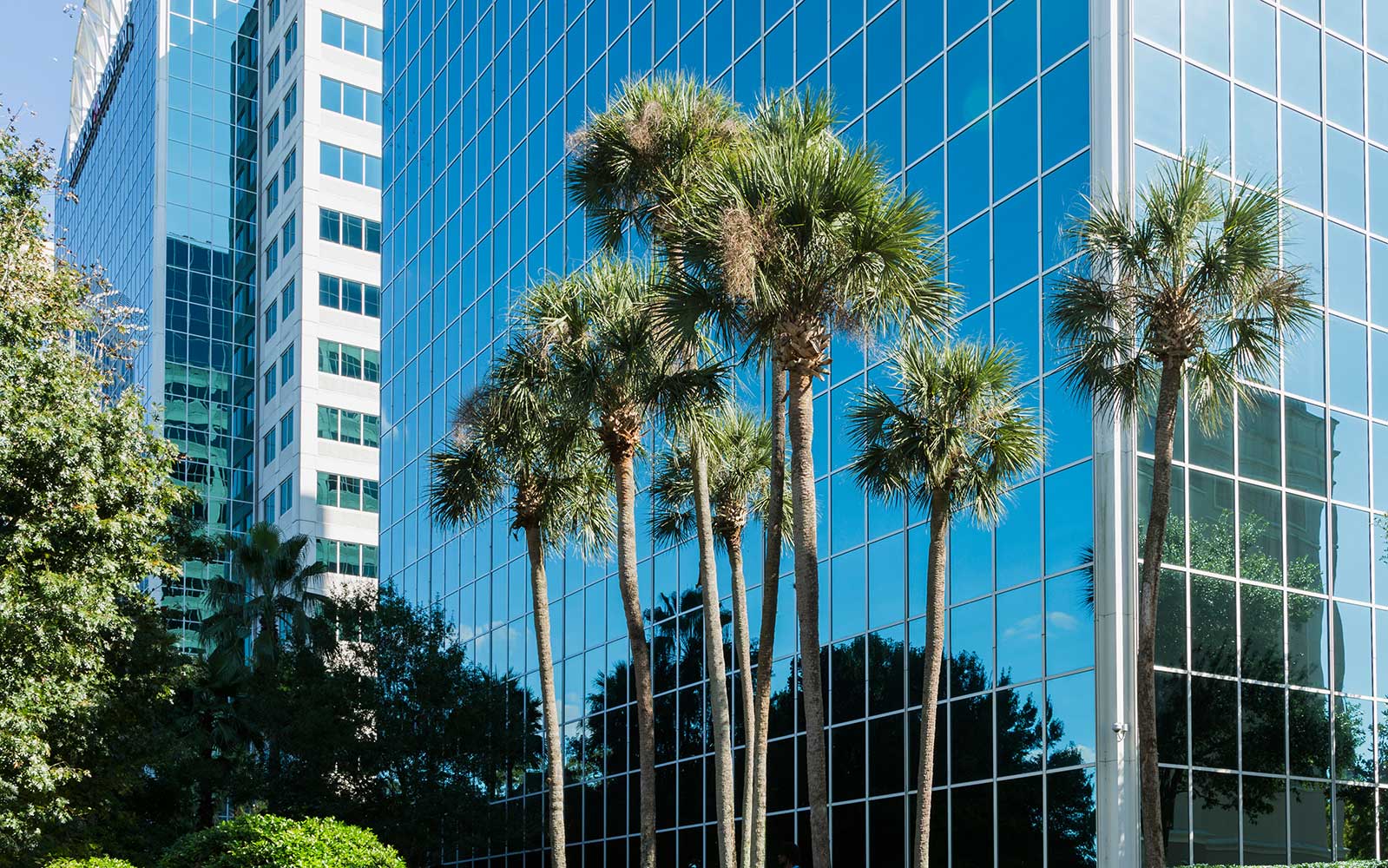
April 30, 2021
Florida is one of only two states that does not require out-of-state retailers to collect and remit sales tax, but that is about to change. The Florida Senate and House of Representatives passed Senate Bill 50 (SB 50) by a supermajority in both chambers and the measure was recently signed by Gov. Ron DeSantis. Under SB 50 new sales tax revenue is first directed towards replenishing the Unemployment Compensation Trust Fund and will later be used to pay for a 3.5% reduction of Florida’s Business Rent Tax. [5.5% to 2%, effective 2025, or upon replenishment of the unemployment compensation trust fund.] Cuhaci and Peterson is proud to stand at the forefront our industry partners by providing continued advocacy for regulatory relief and reform.
Let’s take a closer look at what the bill passage means to our partners and customers:
As you may know, Florida is one of the last states with a state sales tax to pass e-fairness legislation. In the wake of the 2018 U.S. Supreme Court South Dakota v. Wayfair case, most states were quick to utilize their new authority to collect online sales taxes, leveling the playing field for community-based retailers. With this development, Missouri is the only sales tax state that has not adopted a policy to collect remote sales taxes from out-of-state-sellers. The passage of SB 50 is a major legislative victory for Florida’s brick and mortar retailers and is an opportunity for the state to collect this additional sales tax revenue.
If you have any questions about the bill please do not hesitate to contact me at bill.tomala@c-p.com
About Cuhaci Peterson®
Cuhaci Peterson is a nationally recognized architecture, engineering and planning firm specializing in end-to-end commercial design solutions. Headquartered in Central Florida, the firm has representatives throughout the United States and is licensed in all 50 states. Cuhaci Peterson’s mission of transforming ideas into a value is enhanced by a staff of experts who collaborate with clients to translate visions into designs that elevate brands.
Kraig Koelsch
Manager, Marketing and Communications
407-661-9100
kraig.koelsch@c-p.com
Cuhaci Peterson Maitland (HQ)
Subscribe to our newsletter and get the latest news and updates

December 17, 2020
As the year 2020 reaches its end, so do many items in the Florida Building Code. The 2020 Florida Building Code 7th Edition goes into effect on January 1, 2021. Any project submitted to a jurisdiction on this date (Jan. 1, 2021) will have to conform to the new 2020 code. In our second installment of a blog series aimed at examining these code changes, we’ll take a look at noteworthy changes in fuel gas code. These changes are important as we look to address project scope and identify additional costs for our business and potentially, our customers.
Here are some key changes to take note of:
So why does this even matter? A substitution may arise where a contractor wishes to use CSST. If this happens, only accept the arc-resistant CSST. The following link provides a very good explanation of the differences between the two.
If you’d like to see the changes on the state website, you can do so by clicking here. In future installments of this series, we’ll take a look at changes to Florida building code in mechanical, and energy conservation.
About Cuhaci Peterson®
Cuhaci Peterson is a nationally recognized architecture, engineering and planning firm specializing in end-to-end commercial design solutions. Headquartered in Central Florida, the firm has representatives throughout the United States and is licensed in all 50 states. Cuhaci Peterson’s mission of transforming ideas into a value is enhanced by a staff of experts who collaborate with clients to translate visions into designs that elevate brands.
Kraig Koelsch
Manager, Marketing and Communications
407-661-9100
kraig.koelsch@c-p.com
Cuhaci Peterson Maitland (HQ)
Subscribe to our newsletter and get the latest news and updates
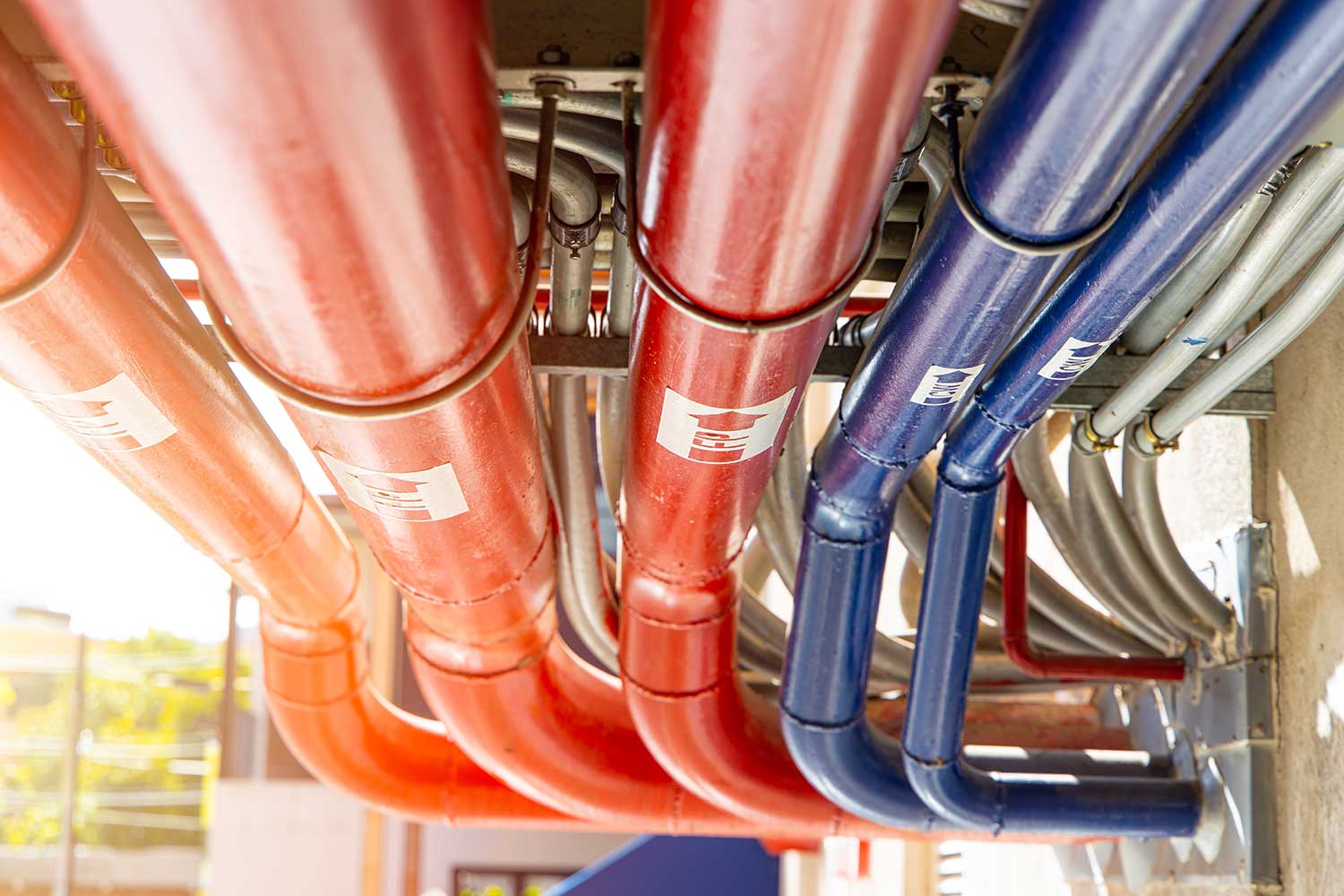
December 1, 2020
As the year 2020 reaches its end, so do many items in the Florida Building Code. The 2020 Florida Building Code 7th Edition goes into effect on January 1, 2021. Any project submitted to a jurisdiction on this date (Jan. 1, 2021) will have to conform to the new 2020 code. In our first installment of a blog series aimed at examining these code changes, we’ll take a look at noteworthy changes in plumbing code. These changes are important as we look to address project scope and identify additional costs for our business and potentially, our customers.
Here are seven changes to take note of:
If you’d like to see the changes on the state website, you can do so by clicking here. In future installments of this series, we’ll take a look at changes to Florida building code in mechanical, fuel, gas and energy conservation.
About Cuhaci Peterson®
Cuhaci Peterson is a nationally recognized architecture, engineering and planning firm specializing in end-to-end commercial design solutions. Headquartered in Central Florida, the firm has representatives throughout the United States and is licensed in all 50 states. Cuhaci Peterson’s mission of transforming ideas into a value is enhanced by a staff of experts who collaborate with clients to translate visions into designs that elevate brands.
Kraig Koelsch
Manager, Marketing and Communications
407-661-9100
kraig.koelsch@c-p.com
Cuhaci Peterson Maitland (HQ)
Subscribe to our newsletter and get the latest news and updates
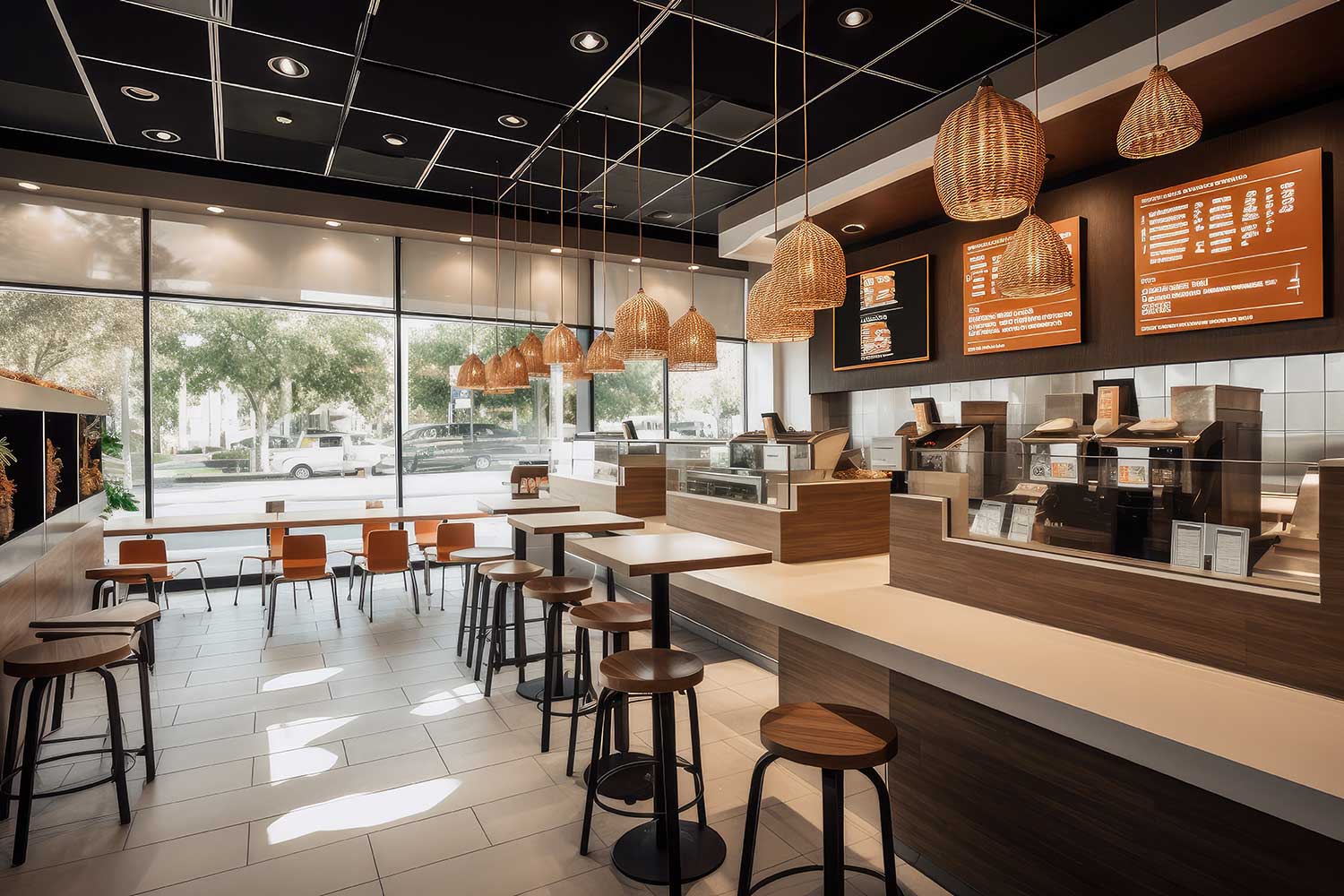
October 15, 2020
Too early? Too optimistic? Maybe, but the alternative can be difficult to swallow after eight long months of uncertainty. During this time, the convenience industry has aggressively engaged in application advancement, curbside pick-up, delivery and modifying existing buildings and sites to accommodate drive-throughs. We even had one of our clients transition their operations in the quick-service restaurant (QSR) world (Wawa Inc., 2020). Those actions leave me optimistic because that is what successful business owners do when faced with opposition. They adapt, invent, and re-invent through adversity.
In recent years, the convenience market has been in an acquisition race and according to Convenience Store News, has left just six companies that are owner/operators of 1,000 stores or more, eight with 500-1,000 stores and just 35 with 100-500 stores. I believe this consolidation has helped insulate the market during this economic storm but has also made it a challenge for those who may be outside of that Top 50.
So, what is that “thing” that can be the equalizer for all owner/operators in the convenience industry post-COVID? Frictionless checkout. This technology was all the talk in 2018 as Amazon Go stores began to open in Seattle. Our R&D team invested a significant amount of time analyzing systems and suppliers to better inform our clients. As we presented these findings to various partners, there was a general sense that it was a little too trendy and perhaps, too gimmicky. In areas where the demographics were tech-centric, maybe. But is that also true for typical suburban US markets?
We are fortunate to work with some of the largest retailers and grocers in the country, so we have a great sounding board when the “next big thing” comes along. Perhaps jumping in with the early adopters on such a significant customer and operational shift did not make the most sense. However, if COVID-19 has proven anything, it has shown how quickly we adapt.
When Ricker’s convenience stores implemented frictionless checkout technology into their 58 convenience stores in 2018, they had no lens what a post-pandemic world would look like. Circle K, recently announced their launch of Mastercard’s new frictionless checkout product. And while they (like the rest of us) can’t say with certainty what happens next, they are hedging their bets that although humanity will still desire human interaction in a post-COVID world, we will likely appreciate a few less contact points. This may only be one type of technology but according to Capgeminie Research Institute, 60% of consumers believe that long queues are a major pain point that customers face in stores while only 33% of retailers agree. This research also notes that 59% of consumers who have previously visited stores with automation would shift purchases to a store with automation technologies if they had a positive experience.
With this type of data in mind, we dusted off those notes and have re-engaged vendors to help ensure that we both are up-to-speed on the advancements those early adopters made. In the end, our goal is to educate and assist our clients enabling them for success in a post-COVID world.
About Cuhaci Peterson®
Cuhaci Peterson is a nationally recognized architecture, engineering and planning firm specializing in end-to-end commercial design solutions. Headquartered in Central Florida, the firm has representatives throughout the United States and is licensed in all 50 states. Cuhaci Peterson’s mission of transforming ideas into a value is enhanced by a staff of experts who collaborate with clients to translate visions into designs that elevate brands.
Kraig Koelsch
Manager, Marketing and Communications
407-661-9100
kraig.koelsch@c-p.com
Cuhaci Peterson Maitland (HQ)
Subscribe to our newsletter and get the latest news and updates

July 29, 2020
More good news for businesses wanting to move projects forward in Orange County. On July 28 the Orange County Division of Building Safety unanimously approved amendments allowing companies to defer paying impact fees and exempt the payment of transportation impact fees for change-of-use permits up to $100,000. The incentive program starts August 3 and is set to end July 30, 2021. For Cuhaci Peterson, this means existing and potential clients can not only retain funds until the end of construction, but also help boost the construction industry, which as been hit hard by the coronavirus pandemic.
“We are excited to see this move by Orange County,” said Jeff Suchan, Chief Development Officer. “It shows their commitment to help bolster the local economy. Our hope is that developers will take advantage of this incentive and move projects forward quicker, which will then create more job opportunities,” he noted.
The deferment will apply to all types of impact fees, including those related to fire services, transportation, schools, parks, and law enforcement. Instead of being collected when a building permit is issued, fees will now be due either at the time a development’s first building receives pre-power or the first certificate of occupancy is issued, whichever comes first. With the $100,000 cap on the exemption, any amount above that will still have to be paid.
Keith Brown, Director of Permitting Services at Cuhaci Peterson, said his team is ready to guide clients every step of the way. “The Permitting team is here to help with all permitting needs, like project due diligence, permit application completion, electronic submittals, tracking from beginning to end, and all coordination with design & construction teams toward successful project completion,” he explained. “We are here to participate and contribute where necessary throughout this process as Orange County gives back to the community.”
This latest incentive program comes weeks after county commissioners voted to supplement permit fees up to $10 million during a six-month period. That initiative began July 13 and will end either January 15, 2021, or when the funds are exhausted. Overall, these deferments from Orange County are a win-win across the board.
“This incentive to delay the payment of impact fees along with the previously approved waiving of permitting fees will continue to be a great benefit to development,” Suchan exclaimed. “Cuhaci Peterson is ready and willing to help with the process of getting projects through the Permitting process to take advantage of these incentives.”
About Cuhaci Peterson®
Cuhaci Peterson is a nationally recognized architecture, engineering and planning firm specializing in end-to-end commercial design solutions. Headquartered in Central Florida, the firm has representatives throughout the United States and is licensed in all 50 states. Cuhaci Peterson’s mission of transforming ideas into a value is enhanced by a staff of experts who collaborate with clients to translate visions into designs that elevate brands.
Kraig Koelsch
Manager, Marketing and Communications
407-661-9100
kraig.koelsch@c-p.com
Cuhaci Peterson Maitland (HQ)
Subscribe to our newsletter and get the latest news and updates
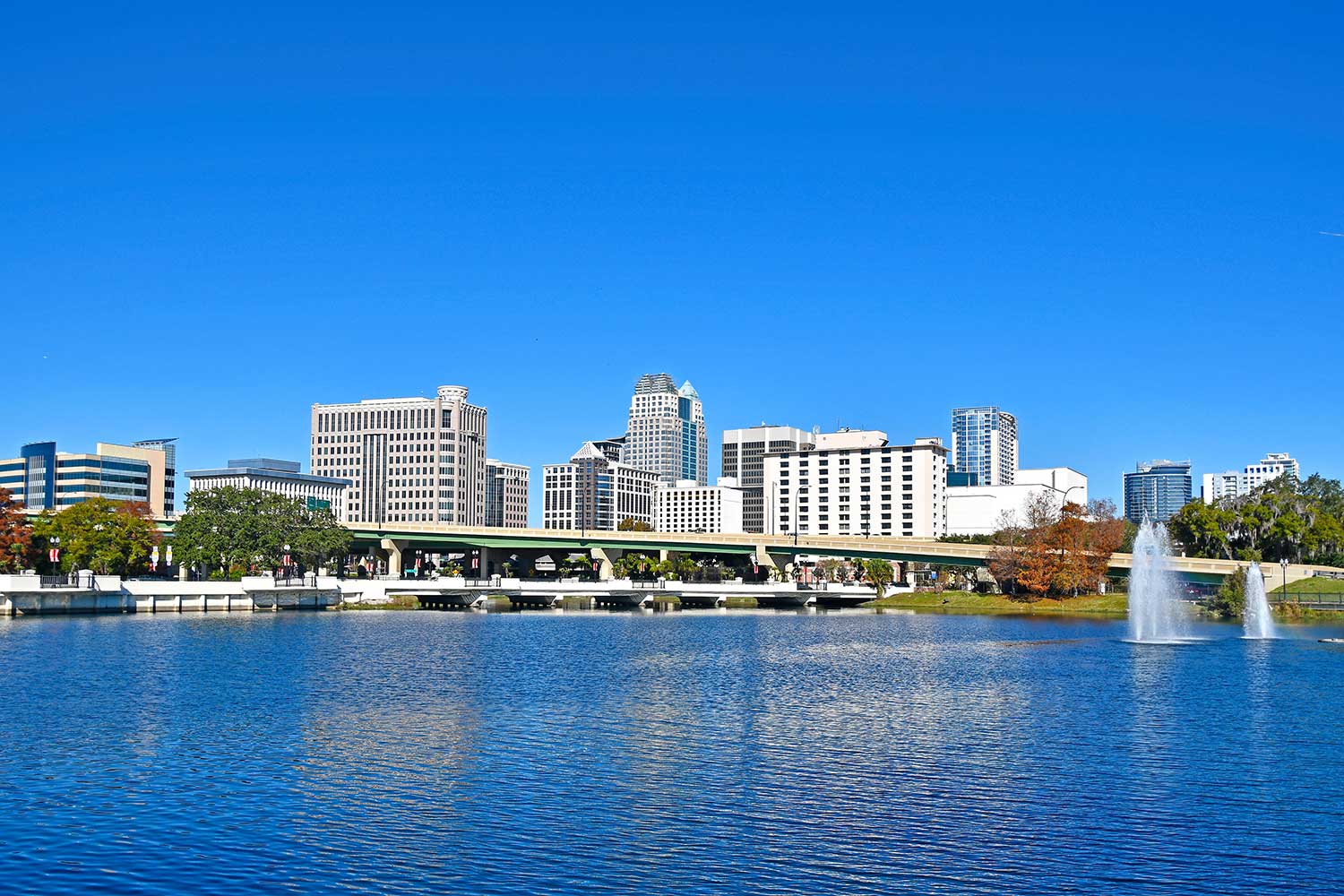
July 9, 2020
To support new construction and stimulate the economy, the Orange County Division of Building Safety recently passed an economic plan that will supplement permit fees up to $10 million during a six-month period. This means applicants can get their building permitting fees waived (up to $100,000) while ensuring all construction meets required approvals and inspections.
At Cuhaci Peterson, the measure creates a win-win situation for our existing and potential clients. Keith Brown, CP Director of Permitting Services, said, “After reviewing the published guidelines, we are hopeful that several of the firm’s clients can use this as an opportunity to keep projects moving and possible use the savings they see from this Orange County measure to invest back into other projects and stimulate not only their business but the local economy.”
Here are the details of the new incentive program, which are paid from Orange County’s Division of Building Safety’s reserve funding:
We are here to help get your project started and serve as your guide in the permitting process.
About Cuhaci Peterson®
Cuhaci Peterson is a nationally recognized architecture, engineering and planning firm specializing in end-to-end commercial design solutions. Headquartered in Central Florida, the firm has representatives throughout the United States and is licensed in all 50 states. Cuhaci Peterson’s mission of transforming ideas into a value is enhanced by a staff of experts who collaborate with clients to translate visions into designs that elevate brands.
Kraig Koelsch
Manager, Marketing and Communications
407-661-9100
kraig.koelsch@c-p.com
Cuhaci Peterson Maitland (HQ)
Subscribe to our newsletter and get the latest news and updates

May 5, 2020
We understand the impacts of the disruption Covid-19 is having on our clients, our businesses and our personal lives and are getting to know each other on a different level, as a result. Our Wawa team wanted to do something to let our partners at Wawa know that they are 100% committed to the same level of service and communication that they have always had, no matter where they were or how they have to do it.
Program Director, Nathan Griffis said: “Our team is passionate about serving our client Wawa and the personal relationships that we have with them. Many team members have been a part of this nearly 10-year partnership and our former LMA members much longer than that. Frankly, the disruption that Covid-19 has been to that communication inspired our team to prepare this message for Wawa. A message that says we have not, and are not, going anywhere. We have taken these changes in stride and are leveraging great technology that will, in fact, make us stronger as a team. The DNA of our firm says that we have survived a lot over our 40+ years and we will live to tell about this event as well. So, wherever we are, we are CP.”
About Cuhaci Peterson®
Cuhaci Peterson is a nationally recognized architecture, engineering and planning firm specializing in end-to-end commercial design solutions. Headquartered in Central Florida, the firm has representatives throughout the United States and is licensed in all 50 states. Cuhaci Peterson’s mission of transforming ideas into a value is enhanced by a staff of experts who collaborate with clients to translate visions into designs that elevate brands.
Kraig Koelsch
Manager, Marketing and Communications
407-661-9100
kraig.koelsch@c-p.com
Cuhaci Peterson Maitland (HQ)
Subscribe to our newsletter and get the latest news and updates

April 22, 2020
Fifty years ago, today, the first Earth Day was held as “a unified response to an environment in crisis”, according to earthday.org. Cuhaci Peterson Vice President of Design, Steven Duffy recalled his participation in the inaugural event, “I remember planting a tree on the 1st Earth Day.”Over the years, Cuhaci Peterson has had some fun celebrating Earth Day. In 2014, NASA encouraged people to submit #GlobalSelfies.
Half a century later, the leaps and bounds that the world has made influence how we all live and work on a daily basis. Architecture and Engineering is no exception. One of our LEED Certified professionals, Director of Architecture, Chris Renegar, gave his insights on what this day means to him each year.
“Earth Day marks a time to reflect on our environmental heritage and responsibility to both maintain and enhance our environment at a local, national, and global scale. As a Design Professional that has studied and practiced sustainable design for buildings in the retail environment, it is good to see that many of the sustainable elements of the U.S. Green Building Council’s Leadership in Energy and Environmental Design (LEED) and the Green Building Initiative’s Green Globes program are being implemented into mainstream practice through new building code requirements along with state and local incentive programs. Therefore, today we are witnessing broader and ever-increasing participation incorporating sustainable design into both new and existing buildings than ever before. An important and necessary transformation as residential and commercial buildings are responsible for approximately 40 percent of U.S. energy consumption*.”
Each year our industry and our world make progress. We are working within our firm to lessen our carbon footprint in our office buildings (that are currently missing as we telework) and we will continue to be a resource to our clients as they incorporate more and more green into the projects we work on moving forward. Step by step, we’ll make a difference!
About Cuhaci Peterson®
Cuhaci Peterson is a nationally recognized architecture, engineering and planning firm specializing in end-to-end commercial design solutions. Headquartered in Central Florida, the firm has representatives throughout the United States and is licensed in all 50 states. Cuhaci Peterson’s mission of transforming ideas into a value is enhanced by a staff of experts who collaborate with clients to translate visions into designs that elevate brands.
Kraig Koelsch
Manager, Marketing and Communications
407-661-9100
kraig.koelsch@c-p.com
Cuhaci Peterson Maitland (HQ)
Subscribe to our newsletter and get the latest news and updates

April 15, 2020
With recent events of COVID-19, the United States has seen massive slow downs or halts of work in the industries of architecture, engineering, and construction. Statewide mandated quarantines and self-isolation have forced the hand of the industry. Though some – like grocery, gasoline, pharmacy, automotive service, and other related chains – continue to function to service America’s needs. Thankfully, some of those retailers happen to be on the list of Cuhaci Peterson’s clients. These areas include design, permitting, and construction administration.
Organizational and process related standards & regulations still allow all jurisdictions to remain open and functioning per normal. Doors have been closed to the public, but staff have been put on either rotational shifts or are working from home. These changes put delays on review times, how packages are submitted, and interaction with review and/or intake employees. Despite the COVID-19 spread and mandated quarantines, there has been an upside to ensuring permit submissions are fluid.
A large percentage of jurisdictions have adopted electronic and/or email submissions for plan review. FTP sites have been created and email servers are being utilized in cities and towns that have not used them before. This allows our Permitting department to truly practice social distancing and not put employees in harm’s way by coming in contact with the general public. Thanks to these changes and quick adjustments, C&P is able to maintain Out to Permit (OTP) dates to meet the needs of each client and obtain permits to keep projects on schedule once this virus spread subsides.
Cuhaci Peterson remains optimistic despite this pandemic and continues to push each and every employee to perform to a high standard to meet client’s needs. Sustaining a safe and healthy workforce is the priority. With this, architectural & engineering design maintains its quality, permit due diligence, submissions are completed on time, and construction administration continues to push for successful schedule deadlines and closeout. This is what C&P stands behind.
About Cuhaci Peterson®
Cuhaci Peterson is a nationally recognized architecture, engineering and planning firm specializing in end-to-end commercial design solutions. Headquartered in Central Florida, the firm has representatives throughout the United States and is licensed in all 50 states. Cuhaci Peterson’s mission of transforming ideas into a value is enhanced by a staff of experts who collaborate with clients to translate visions into designs that elevate brands.
Kraig Koelsch
Manager, Marketing and Communications
407-661-9100
kraig.koelsch@c-p.com
Cuhaci Peterson Maitland (HQ)
Subscribe to our newsletter and get the latest news and updates
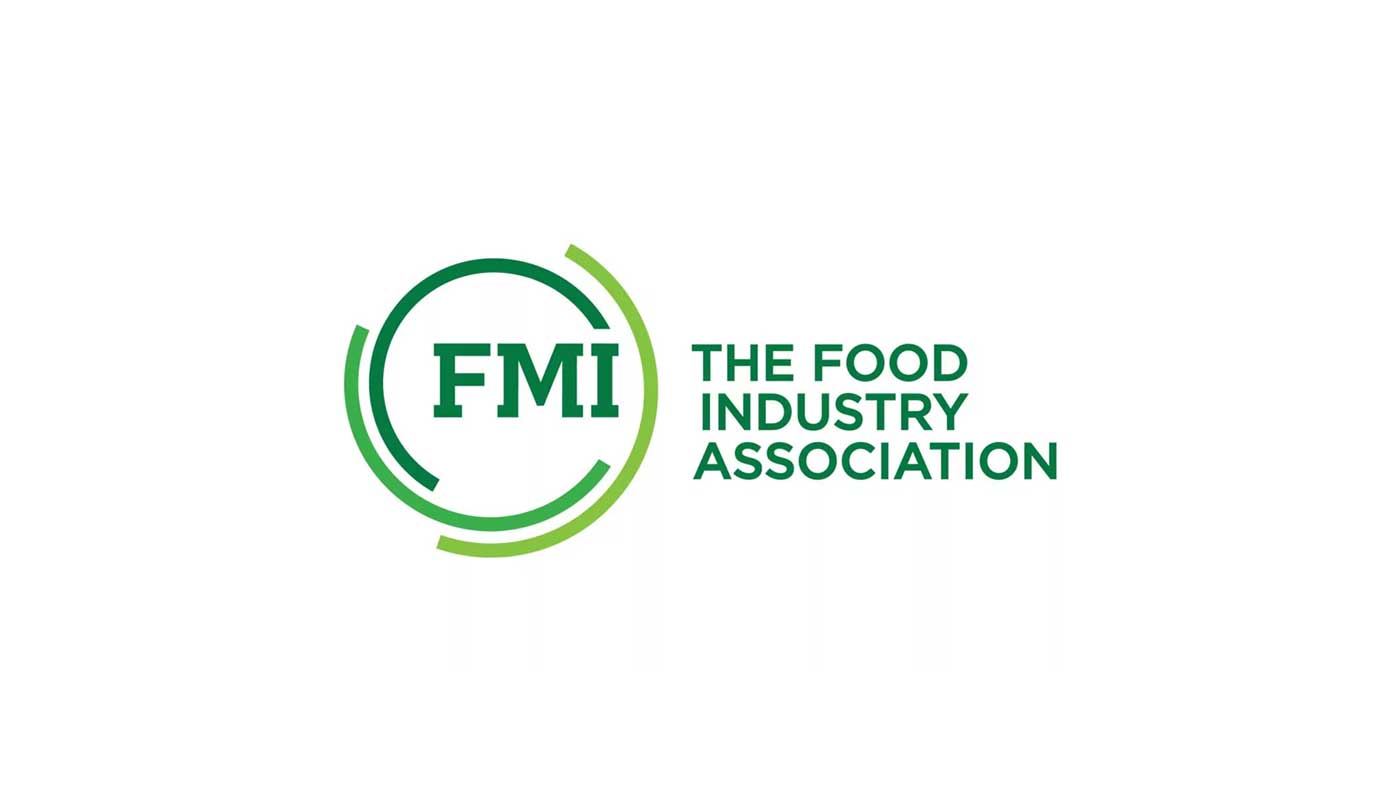
January 22, 2020
Already in 2020, we’ve seen two organizations changing their brand identities with similar goals of broadening their representation of the industry. Just last week, the Grocery Manufacturing Association became the Consumer Brands Association, and now it’s the Food Marketing Institute’s (FMI) turn.
FMI is now officially FMI – The Food Industry Association. According to the trade organization, the move supports a more interconnected supply chain, with retail as the heart of the food industry. FMI recently expanded its membership to facilitate this evolving view.
“Over the last two years, we’ve inspired a recommitment, a renewal of vows among the FMI membership,” said Joe Sheridan, president and COO of Keasbey, N.J.-based Wakefern Food Corp., and chairman of the FMI board of directors. “We’ve even changed who can be a member in the association as a logical step in a direction we’ve been traveling for years, offering greater parity between retailers and their product supplier partner members at the board of directors level.”
About Cuhaci Peterson®
Cuhaci Peterson is a nationally recognized architecture, engineering and planning firm specializing in end-to-end commercial design solutions. Headquartered in Central Florida, the firm has representatives throughout the United States and is licensed in all 50 states. Cuhaci Peterson’s mission of transforming ideas into a value is enhanced by a staff of experts who collaborate with clients to translate visions into designs that elevate brands.
Kraig Koelsch
Manager, Marketing and Communications
407-661-9100
kraig.koelsch@c-p.com
Cuhaci Peterson Maitland (HQ)
Subscribe to our newsletter and get the latest news and updates
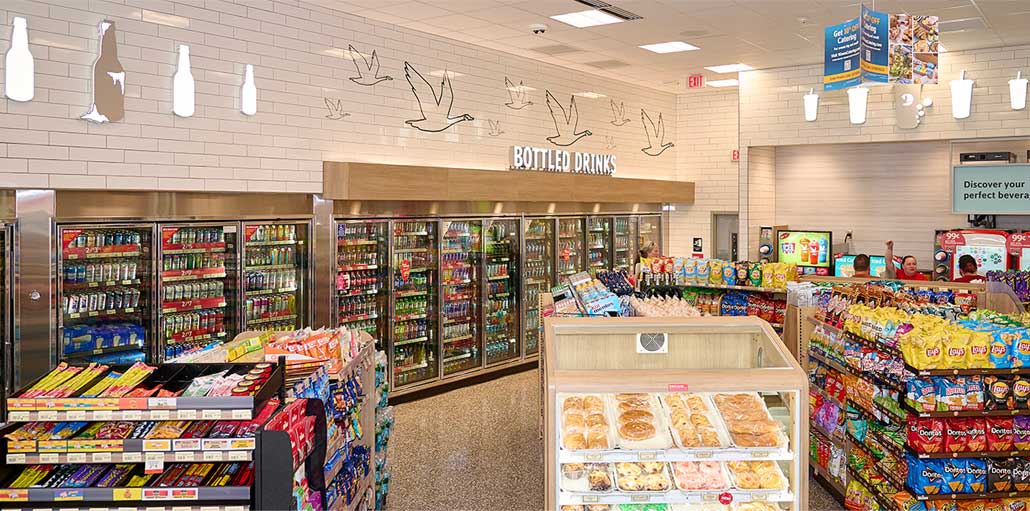
January 20, 2020
Via (CNN) — In “Vacation,” National Lampoon’s 1980s classic, Chevy Chase jokes, “I’m so hungry. I could eat a sandwich from a gas station.”
But the convenience stores and gas stations that dot America’s retail landscape have worked to improve their dinners-to-go and coffee. Today, chains like Sheetz, Wawa and Kwik Trip offer meal kits, salads, keto snacks, Kombucha and espressos. That overhaul is driving convenience stores’ rise, unexpected survivors in an industry suffering mass store closings and shoppers shifting online. While delivery from Amazon has redefined what convenience means for many Americans, the 24-hour, 3,230-average-square-foot convenience store still fills a niche for time-strapped customers searching for a bite to eat and a fill up at the pump.
“It has absolutely been a hidden gem,” said Jeff Williams, senior vice president of retail services at Nielsen. “They are demanding that consumers view them as a destination for food.”
Convenience stores have reinvented their businesses to adjust to the changing ways Americans eat. Snacking is becoming consumers’ preferred meal of choice, and Americans are cooking fewer of their dinners at home as they eat out or order in from their couch. To keep up, chains are hiring executives from restaurants and expanding their snack choices and prepared food in kitchens on site. Consumers, especially Millennials, are not always willing to go to a quick-service restaurant, a fast-food joint or walk around a 40,000-square-foot grocery store, analysts say. Instead, they’ll often head to a convenience store, where the average amount of time customers spend inside the store is less than four minutes.
“People simply don’t have the time to sit down a whole meal at night like they used to,” said Carl Rick, leadership development specialist at Kwik Trip, which is building around 40 stores a year and just opened its 700th. “The more places there are where people can duck in, be out in three minutes with milk, eggs, maybe a sandwich, something to drink—those places are doing very well.”
About Cuhaci Peterson®
Cuhaci Peterson is a nationally recognized architecture, engineering and planning firm specializing in end-to-end commercial design solutions. Headquartered in Central Florida, the firm has representatives throughout the United States and is licensed in all 50 states. Cuhaci Peterson’s mission of transforming ideas into a value is enhanced by a staff of experts who collaborate with clients to translate visions into designs that elevate brands.
Kraig Koelsch
Manager, Marketing and Communications
407-661-9100
kraig.koelsch@c-p.com
Cuhaci Peterson Maitland (HQ)
Subscribe to our newsletter and get the latest news and updates